- Asian Pacific American History
- Women's History
- Collections

Feb. 11 1964, the Beatles' first concert in the United States

Eric Jentsch in our Division of Culture and the Arts shares the story of the first Beatles concert in America, which took place right here in Washington, D.C.
February 11th marks the 48th anniversary of the Beatles' first concert in America. Two days earlier, the group introduced themselves to the nation by performing on New York-based "The Ed Sullivan Show." The "Fab Four" from Liverpool were famously met by more than 3,000 hysterical and nearly riotous fans at JFK airport when they first arrived in the city.
After the concert, the Beatles headed south to Washington, D.C., to play a raucous set before thousands of ecstatic teenagers at the overbooked Washington Coliseum.
![Magazine 2011-0106-28[1] Magazine 2011-0106-28[1]](https://americanhistory.si.edu/sites/default/files/blog_files/a/6a00e553a80e1088340168e71ad8cc970c-500wi.jpg)
American "Beatle-Mania" was a relatively recent development. Devotion to the group came seemingly overnight, with their first song to hit the U.S. charts, "I Want to Hold Your Hand" rocketing to number one that previous December, selling more than 5 million copies in seven weeks. The Beatles then succeeded themselves at the number one spot with "She Loves You," already a hit in England.
Washingtonian Carroll James is the DJ credited with first playing "I Want to Hold Your Hand" on U.S. airwaves. The Beatles' subsequent popularity in the nation's capital inspired the band's visit to the District after their Sullivan performance.
![Ticket envelope 2011-0106-37[1] Ticket envelope 2011-0106-37[1]](https://americanhistory.si.edu/sites/default/files/blog_files/a/6a00e553a80e108834016762196a75970b-500wi.jpg)
A ticket envelope from the Beatles' D.C. concert.
The concert at the now-defunct Washington Coliseum was nothing like the shows that would be staged by rock musicians just a few years later. Sub-par amplification coupled with incessant screaming from throngs of teens made the band hard to hear. The stage was placed in the center of the crowd, forcing members of the band to move their equipment around the stage during the performance in order to face each section of the audience. This was especially inconvenient to percussionist Ringo Starr, who was responsible for moving his large drum-kit about numerous times throughout the night.
None of this seemed deter the enjoyment of the hysterical crowd, whose screaming continued unabated throughout the entire performance. After sitting through opening acts The Caravelles, Tommy Roe, and the Chiffons, fans were given this set by the Beatles: "Roll Over Beethoven;" "From Me to You;" "I Saw Her Standing There;" "This Boy;" "All My Loving;" "I Wanna Be Your Man;" "Please Please Me;" "Till There Was You;" "She Loves You;" "I Want to Hold Your Hand;" "Twist and Shout;" and "Long Tall Sally."
After the appearance, the Beatles went to a party at the British Embassy. They then returned to New York to play two half-hour sets at the famed Carnegie Hall. Their performance on the Ed Sullivan program made the group the talk of the music world, compelling a return trip to the States that summer where they traveled across the country and played larger venues.
Their fantastic success created a "British Invasion" of other English artists inspired by American rock and roll, such as the Rolling Stones and the Kinks, who also found enthusiastic audiences in the United States.
![Ticket 2011-0106-37[1] Ticket 2011-0106-37[1]](https://americanhistory.si.edu/sites/default/files/blog_files/a/6a00e553a80e108834016762196b06970b-500wi.jpg)
A ticket stub from the February 11 concert, donated by Patricia Mink.
A ticket stub from the Beatle's historic appearance in the Smithsonian's hometown was recently given to the National Museum of American History by long-time D.C. resident Patricia Mink, who attended the concert with her friends. Ms. Mink also included other materials from her youth, including concert programs, autographs, and sound recordings. We are thankful for these materials, as they help us tell the story of this exciting, transitional time in American popular culture.

Eric Jentsch is the deputy chair of the Division of Culture and the Arts at the National Museum of American History.
Related Stories

5 intriguing electric guitars from our collections

Go-go, the funky, percussive music invented in Washington, D.C.
Watch CBS News
The Beatles' record-breaking 1964 North American tour
January 28, 2014 / 4:23 PM EST / CBS News
This piece by guest author Chuck Gunderson is part of a series of essays to mark the 50th anniversary of the Beatles' first American television appearance on CBS's "The Ed Sullivan Show." It culminates with CBS News, 50 Years Later...The Beatles at The Ed Sullivan Theater: Presented by Motown The Musical , a live, interactive multimedia event at The Ed Sullivan Theater on Feb. 9.

In February 1964, after finally achieving a number-one hit in America, the Fab Four came to the United States with high hopes, performing on the widely popular Ed Sullivan Show both in New York City and Miami Beach and playing concerts at Carnegie Hall and the Washington Coliseum. In just 15 short days, the Beatles conquered America.
- Complete coverage of The Beatles: 50 Years Later
All told, the first official tour of North America would have the group play a staggering 32 shows in 26 venues in 24 cities in just 33 days. In the end they would walk away richer by $1 million -- in today's dollars, about $7.5 million. GAC's Weiss marveled, "In the more than 15 years that I have been in this business, I do not know of any attraction that has come close to this sort of money in so short a tour."
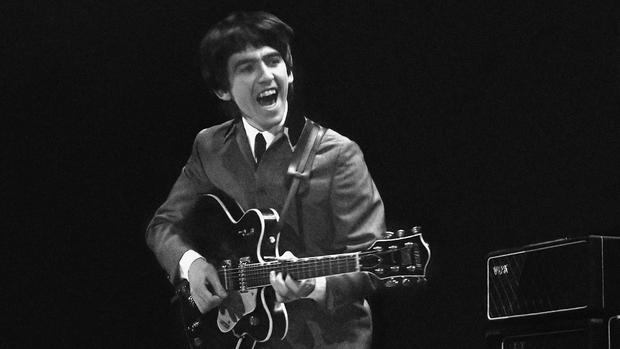
Elaborate plans were drawn up to transport the Fab Four to hotels and venues. These included the use of ambulances, police paddy wagons, armored trucks, and, in one case an empty fish truck. Hucksters as well as managers of fine hotels gathered up bed linens, pillowcases and even the carpet the Beatles walked on to be cut and sold off to fans that were eager to get their hands on anything the Beatles touched.
Perhaps no musical act before or since will ever rival the Beatles on their groundbreaking tour of 1964. John Lennon, Paul McCartney, George Harrison and Ringo Starr would not only leave an indelible impression on their fans in the United States and Canada, but also leave the continent with devotees hungering for more.
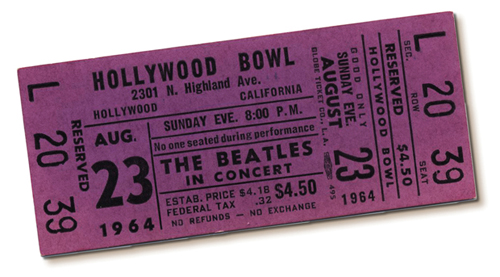
- More on the Beatles from CBS Local
- Win tickets to the live event at the Ed Sullivan Theater on Feb. 9
Chuck Gunderson is author of the upcoming book, “Some Fun Tonight,” an epic two-volume set on the history of the Beatles' North American tours of 1964 to 1966.
More from CBS News
OUR SHOP IS OPEN - COME ON IN www.flashbackshop.com
Visit the shop
The Beatles 1964 First Tour Of The United States – The Photos And The Mania
7th February 2014 marked 50 years since The Beatles first toured the United States. The band were a massive hit . On 9 February 1964 the Fab Four made their first live US television appearance on The Ed Sullivan Show . At 8 P.M, 73 million Americans saw John Paul, George and Ringo play.
On 11 February 1964 The Beatles’ performed in their first US concert, a show at Washington Coliseum, Washington, D.C. Next day, they performed at New York’s Carnegie Hall, New York. They squeezed in another performance on the Sullivan show before returning to the UK on 22 February 1964.
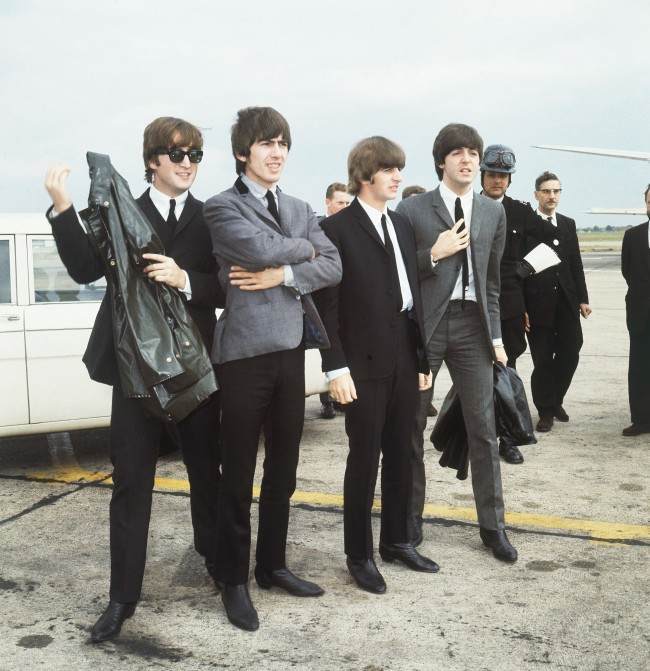
The Beatles leave London airport in 1964. From left: John Lennon, George Harrison, Ringo Starr and Paul McCartney. (AP Photo)
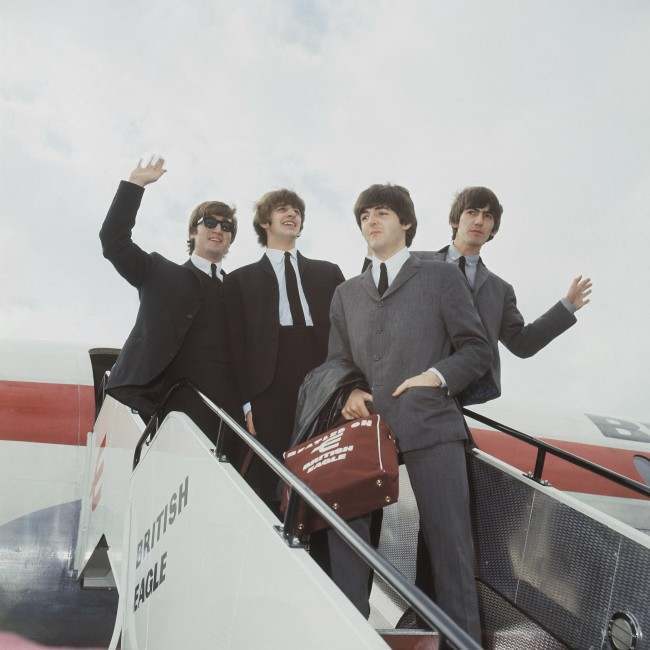
The Beatles leave London airport in 1964. From left: John Lennon, Ringo Starr, Paul McCartney and George Harrison. (AP Photo)
ARRIVING IN NEW YORK

Britain’s Beatles make a windswept arrival in New York on Feb. 7, 1964, as they step down from the plane that brought them from London, at Kennedy airport. From left to right, Ringo Starr, John Lennon, Paul McCartney and George Harrison (AP Photo)

The Beatles arrive at New York’s Kennedy Airport Feb. 7, 1964 for their first U.S. appearance. From left are: John Lennon, Paul McCartney, Ringo Starr and George Harrison. (AP Photo)
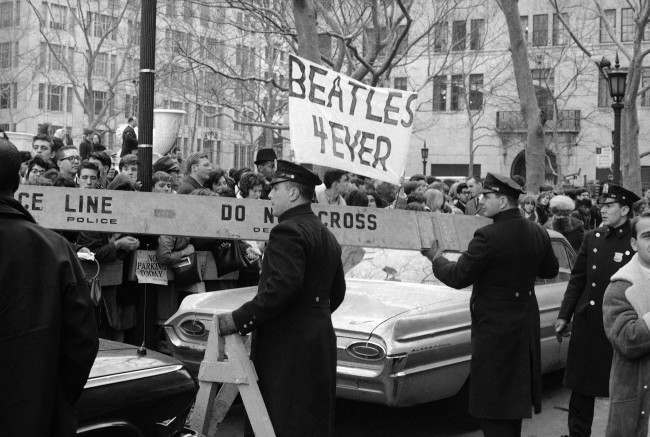
Police man the barricades outside New York’s Plaza Hotel, on Feb. 7, 1964, as Beatle maniacs push forward in hopes of a view of Britain’s singing sensations after their arrival for an American tour. (AP Photo)

Police enforce the barricades outside New York’s Plaza Hotel as fans push forward in hopes of a view of The Beatles after their arrival for an American tour on February 7, 1964. (AP Photo)

The Beatles are shown during a news conference in Forest Hills, N.Y., Feb. 1964. (AP Photo)
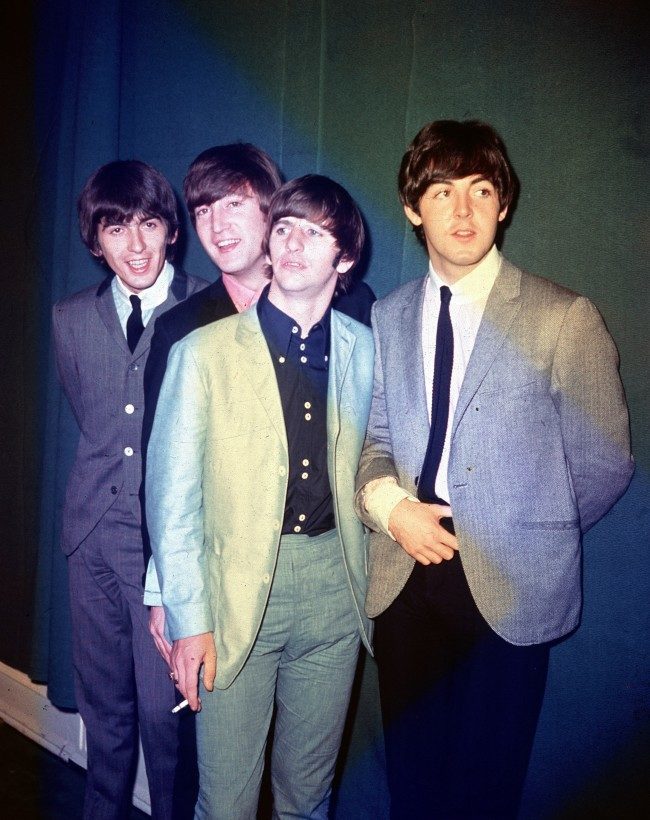
The British rock and roll group The Beatles are seen during their first U.S. tour in 1964. The band members, from left to right, are George Harrison, John Lennon, Ringo Starr and Paul McCartney. (AP Photo)
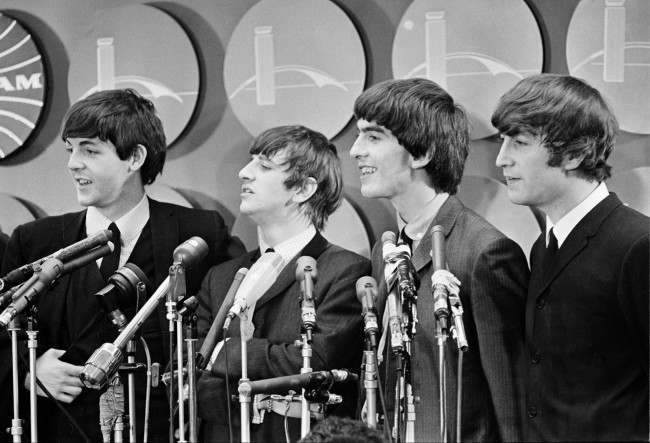
The Beatles meet reporters at Kennedy Airport in New York City, Feb. 7, 1964 on their arrival from London for their first American tour. The band members, from left, are, Paul McCartney, Ringo Starr, George Harrison, and John Lennon. (AP Photo)
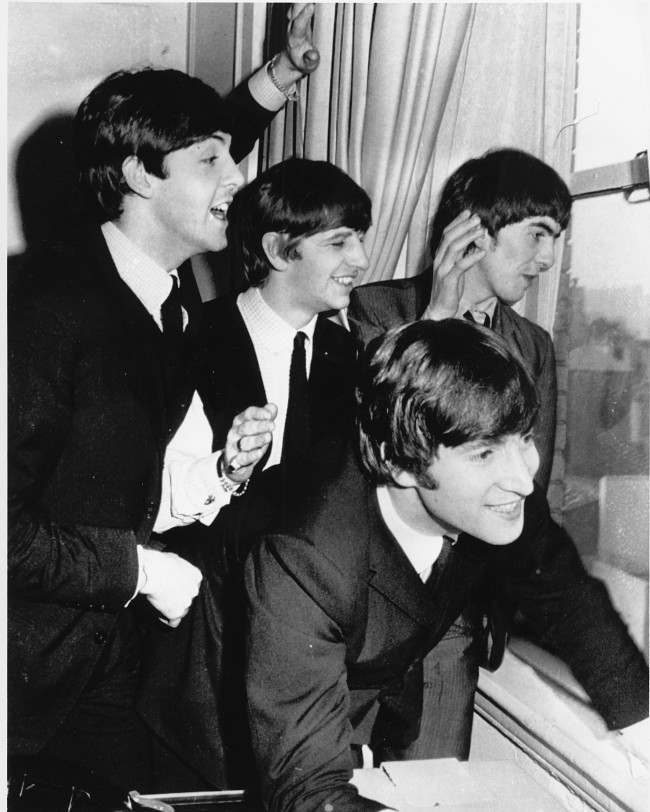
The Beatles wave to fans assembled below their Plaza Hotel window after they arrived in New York City on Feb. 7, 1964 for a short tour of the United States. From left to right are, Paul McCartney, Ringo Starr, John Lennon, and George Harrison. (AP Photo)
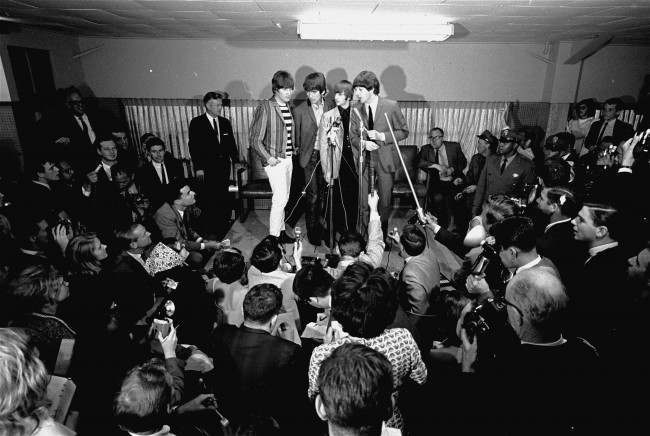
The four members of Britain’s young singing group, the Beatles, stand in front of the microphones in the press room of Kennedy International Airport today during press conference following their arrival, February 7, 1964. From left: John Lennon, George Harrison, Ringo Starr, Paul McCartney. (AP Photo)

The Beatles face the media on arrival at the John F. Kennedy ariport in New York City. Feb. 7, 1964. The British rock and roll group was also greeted by a screaming crowd estimated at 5,000. (AP Photo/Charles Tasnadi)
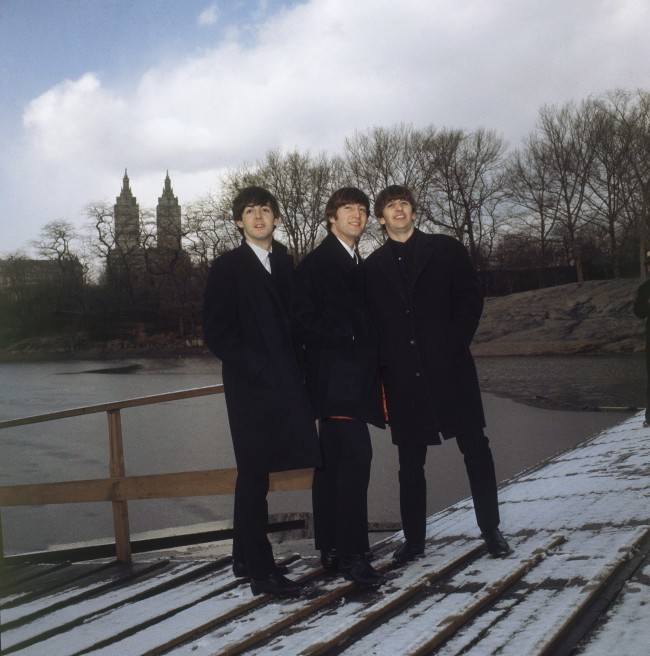
The Beatles walk around New York’s Central Park, Feb. 10, 1964. From left: Paul McCartney, John Lennon and Ringo Starr. (AP Photo)
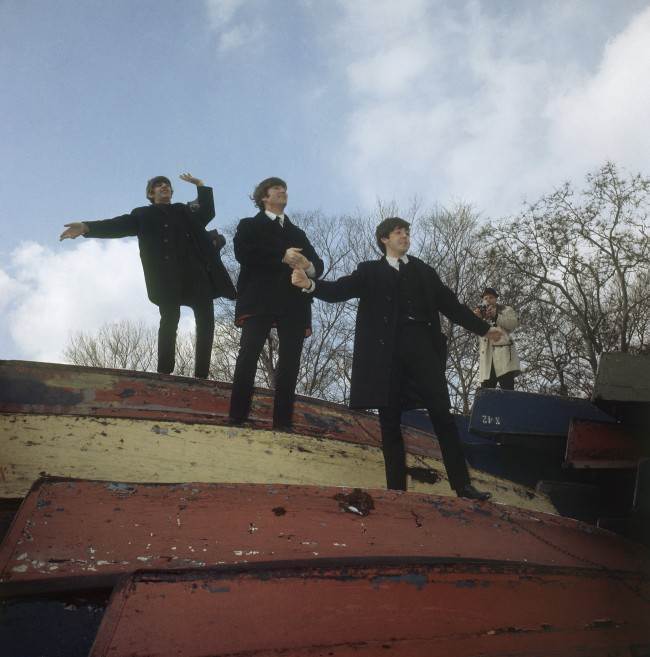
Three members of the Beatles pose on a stack of rowboats in New York’s Central Park, Feb. 10, 1964. From top: Ringo Starr, John Lennon and Paul McCartney. (AP Photo)

John Lennon, center, holds his forehead as 5-year-old Debbie Fyall, of London, England, sits on his shoulders, in New York, Central Park, USA, February 8, 1964. The other two members of the Beatles are Paul McCartney, left, and Ringo Starr, right. (AP Photo/The Beatles)
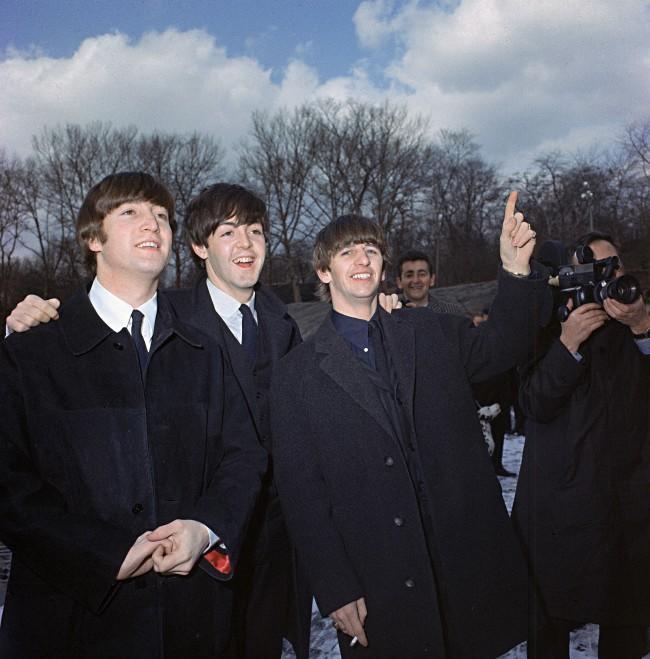
ED SULLIVAN
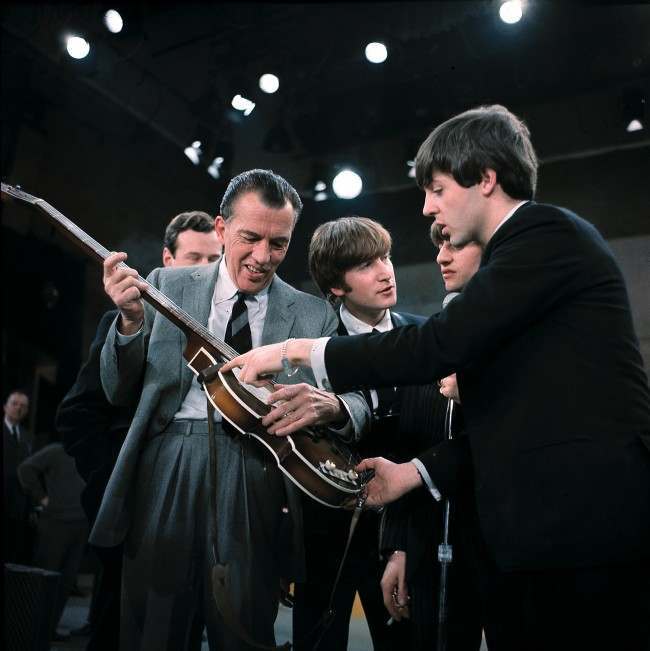
Three of the four member of the British group the Beatles are shown with Ed Sullivan before their live television appearance on The Ed Sullivan Show in New York City, Feb. 10, 1964. From left are, Paul McCartney, Ringo Starr, partial view, George Harrison and Sullivan. (AP Photo)
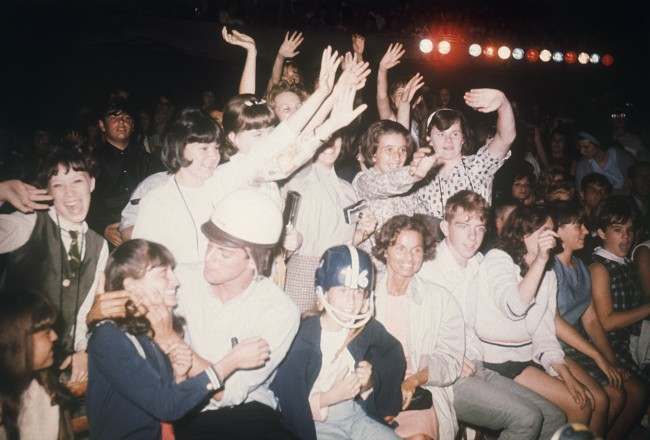
American fans in New York react during the Beatles’ concert on the “Ed Sullivan Show”, Feb. 8, 1964. (AP Photo)
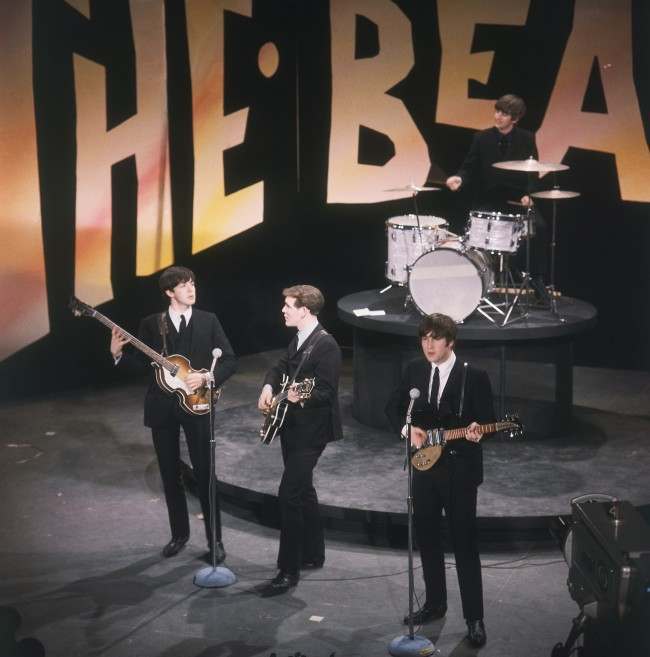
The Beatles, minus an ailing George Harrison, perform on the “Ed Sullivan Show”, Feb. 8, 1964. In front, left to right: Paul McCartney, Neil Aspinall (standing in for Harrison), and John Lennon. On drums is Ringo Starr. (AP Photo)

British rock band the Beatles are shown during rehearsals on the set of the “Ed Sullivan Show” in New York, Feb. 9, 1964. On drums is Ringo Starr, bassist is Paul McCartney, left, and guitarist is John Lennon. (AP Photo)
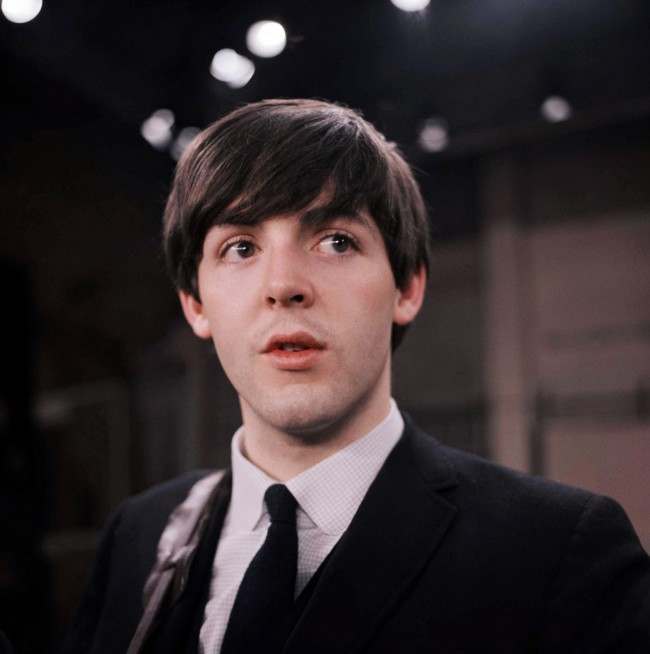
Paul McCartney, bassist for the Beatles, is shown on the set of the Ed Sullivan Show, Feb. 1964. (AP Photo)
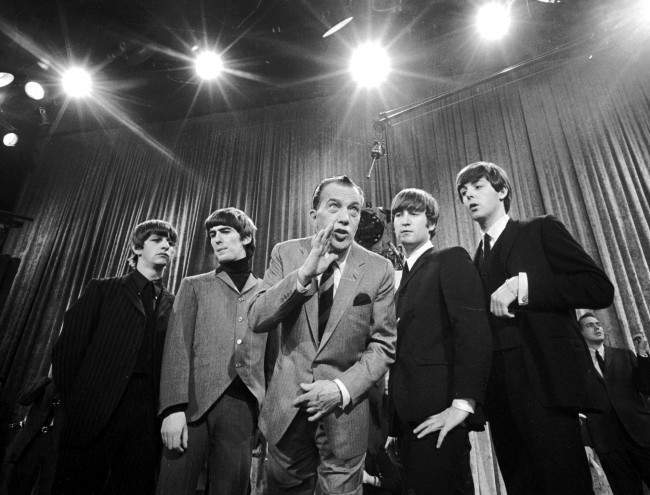
Ed Sullivan, center, stands with The Beatles during a rehearsal for the British group’s first American appearance, on the “Ed Sullivan Show,” in New York. Feb. 9th, 1964. From left: Ringo Starr, George Harrison, Sullivan, John Lennon and Paul McCartney. The rock ‘n’ roll band known as “The Fab Four” was seen by 70 million viewers. “Beatlemania” swept the charts with twenty No.1 hits and more than 100 million records sold. The Beatles broke up in 1970. (AP Photo)

The Beatles perform on the CBS “Ed Sullivan Show” in New York, in this Feb. 9, 1964, file photo. From left, front, are Paul McCartney, George Harrison and John Lennon. Ringo Starr plays drums in the background. The Beatles’ “Love” album is being released on Nov. 21, and is a thorough reinterpretation of their work. (AP Photo/FILE)
WASHINGTON – AN ‘I WAS THERE’ MOMENT
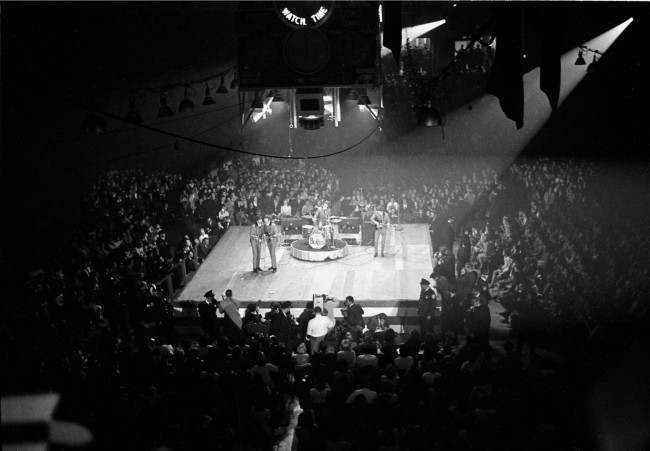
The Beatles perform at the Coliseum in Washington, D.C., Feb. 12, 1964, during their first American tour. The British band members are, in foreground, Paul McCartney and John Lennon; Ringo Starr on drums; and George Harrison on guitar, far right. (AP Photo)
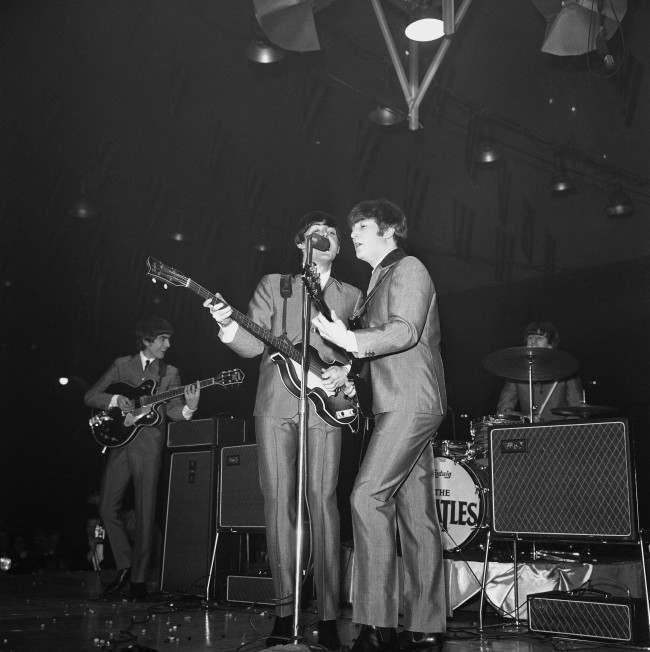
Surrounded by amplifiers and treading jumping beans underfoot, the Beatles swing into their routine during a show at the Coliseum in Washington, Feb. 11, 1964. From left: lead guitarist George Harrison, bassist Paul McCartney, rhythm guitarist John Lennon, and drummer Ringo Starr. The beans were thrown by excited fans. (AP Photo)
DRINKS WITH THE KNOBS
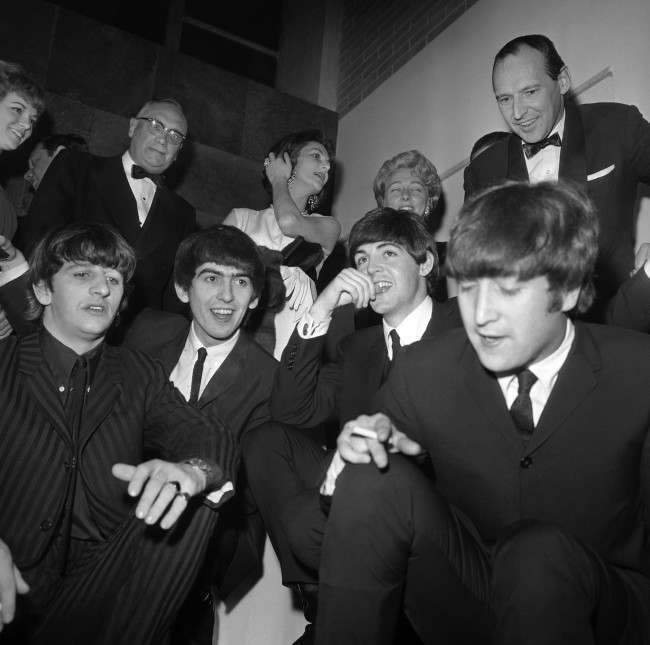
The centre of attraction, four boys from Liverpool enjoy themselves as they attend a charity ball at the British Embassy, in Washington, on Feb. 11, 1964. They are the Beatles , from left: Ringo Starr, George Harrison, Paul McCartney and John Lennon, currently raising a storm on their first tour of the United States. (AP Photo)
NEW YORK GIG
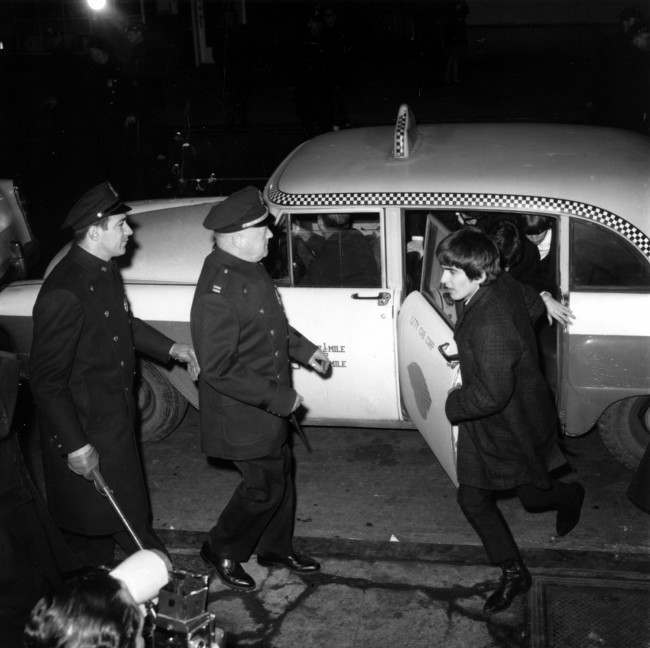
Police security is on hand for the arrival of The Beatles as guitarist George Harrison leads the way from a taxi-cab to Carnegie Hall’s stagedoor on W. 56th St. in New York City on Feb. 12, 1964 . About 2,000 fans are gathered outside the concert hall to catch a glimpse of the British rock and roll band on their first U.S. tour. (AP Photo)
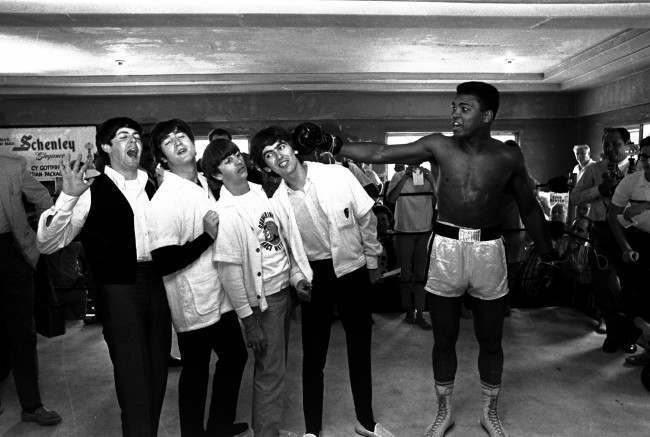
The Beatles, from left, Paul McCartney, John Lennon, Ringo Starr, and George Harrison, take a fake blow from Cassius Clay while visiting the heavyweight contender at his training camp in Miami Beach, Fla. Tuesday February 18,1964.
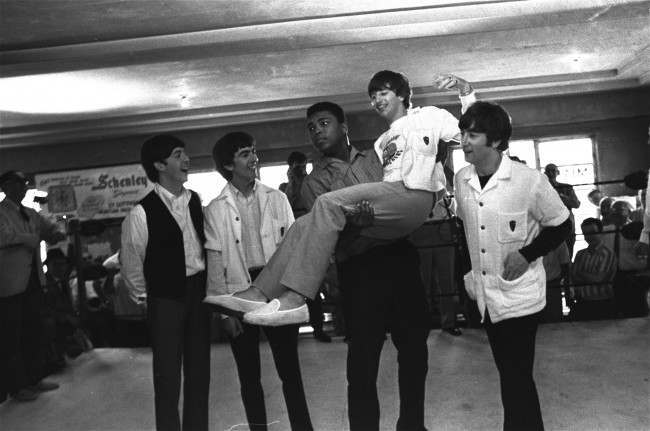
Boxer Cassius Clay lifts Ringo Starr, one of the Beatles into the air while the singers visited Clay’s camp in Miami Beach, Fla. February, 18th, 1964. Others are, from left: Paul McCartney, George Harrison, and John Lennon. (AP Photo)

Ringo Starr of The Beatles Rock group shown on the beach in Florida, February 15, 1964. (AP Photo)
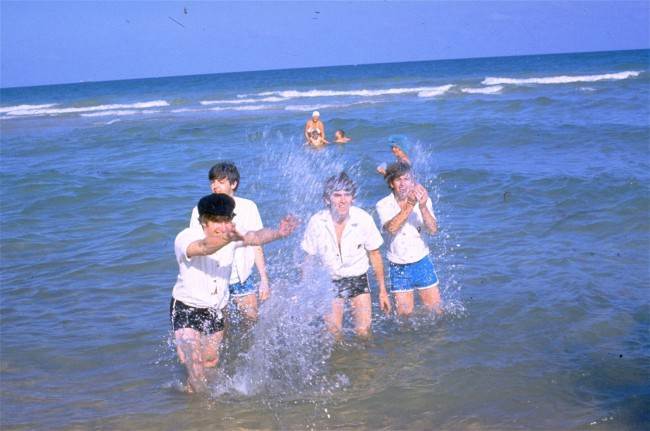
WELCOME HOME
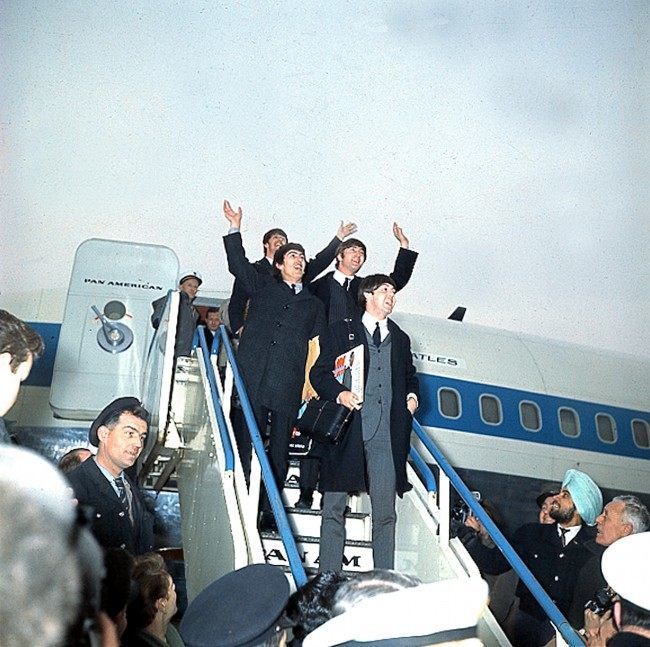
British pop group the Beatles wave as they arrive at London Airport, England, in 1964 after their successful U.S. tour. (AP Photo)

A Beatle fan claws at a metal fence as she welcomes the pop group on their arrival at London Airport, England on Feb 22, 1964. Some 5,000 people, many of whom had waited overnight, were at the airport. (AP Photo)
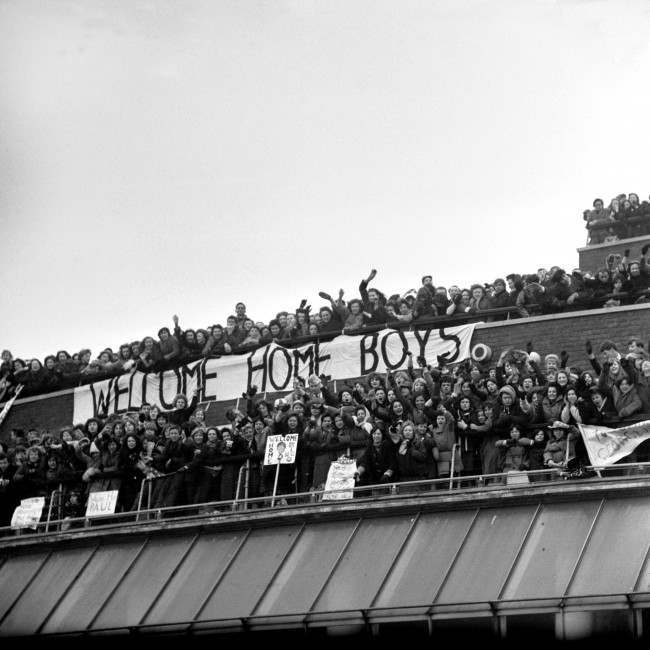
Four thousand fans of The Beatles at London Airport to greet them on their return from a tour of the United States.
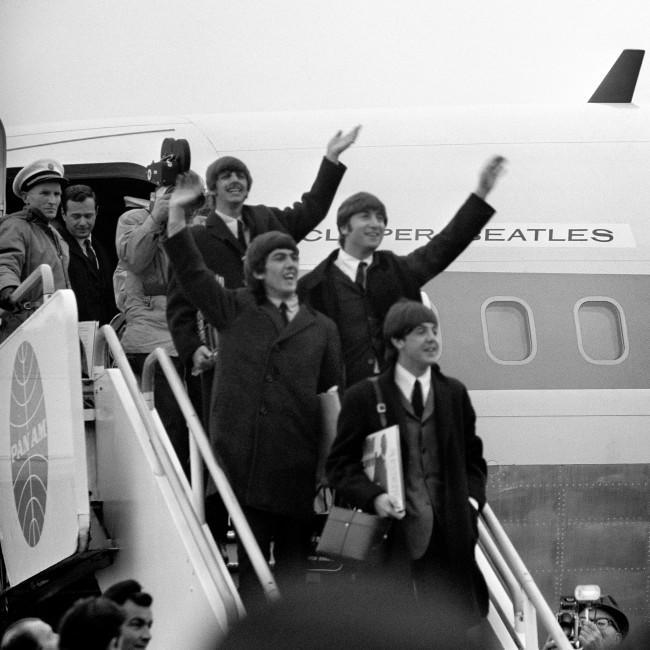
Paul McCartney looks up and acknowledges the waves and screams shortly after arriving with the other three Beatles at London Airport from America.
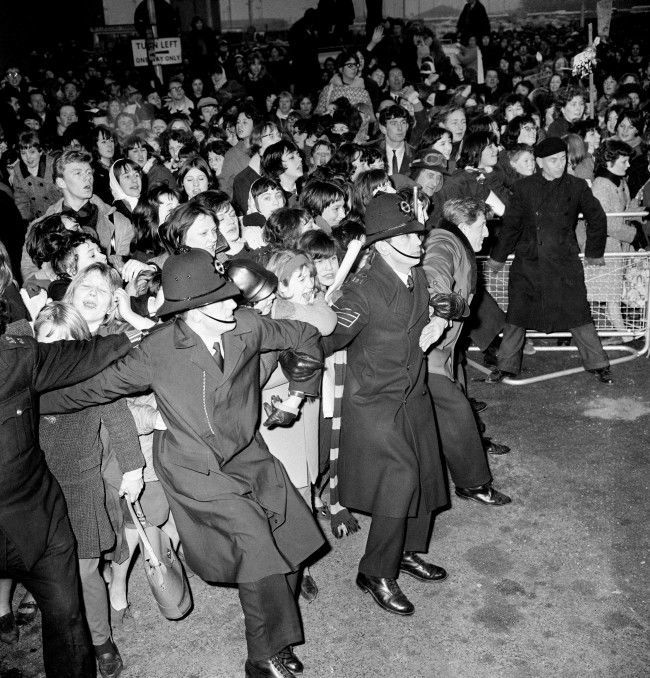
Fans press forward to the restraining linked arms of a chain of extra policemen on duty at London Airport when the Beatles returned from a tour of the United States.
Would you like to support Flashbak?
Please consider making a donation to our site . We don't want to rely on ads to bring you the best of visual culture. You can also support us by signing up to our Mailing List . And you can also follow us on Facebook , Instagram and Twitter . For great art and culture delivered to your door, visit our shop .
OUR SHOP IS OPEN - COME ON IN
www.flashbackshop.com
OUR SHOP IS OPEN – PRINTS, CARDS, TEES & MORE

15% off 3 or more T-Shirts

Recent Posts
Ernest Hemingway’s Guide to Writing A Book From Start to Finish
Why James Bond Gave Up His ‘Lady’s Gun’ For A Walther PPK
Ernest Hemingway’s Six-Word Short Story
1980s Birmingham – Portraits of A City
A Painted Treatise on Cats From 19th Century Thailand
Editor’s picks, collect our postcards.

You Might Also Like
- Pearl Jam Albums Ranked
- Dylan's Favorite Betts Song
- Ringo Starr New Tour
- Allmans' Dickey Betts Dies
- 2024 Summer Tour Preview

When the Beatles Played Their First U.S. Concert
The Beatles made their U.S. concert debut on Feb. 11, 1964 in Washington, D.C., two days after their appearance on The Ed Sullivan Show . They'd arrived from New York by train at Union Station in the middle of a snowstorm.
The show took place at the Washington Coliseum, about a mile north of the U.S. Capitol building. The seating plan for the arena was in its configuration for boxing, with the Beatles setting up on the unroped ring in the middle. This meant that the group were only facing 25 percent of the 8,092 fans in attendance at any given time. In between songs, they moved the amplifiers, microphones and Ringo Starr 's drum riser one-quarter turn clockwise.
Former Vice President Al Gore, who was 15 years old and the son of a U.S. Senator, attended the concert. "The acoustics in the arena combined with the absolute frenzy of enthusiasm made it virtually impossible to understand a single word that they sang," he told the Washington Post . "You had to listen carefully to get the general flow of the song, and of course everybody knew all the words prior to the concert. We all loved their music, but clearly there were a lot of people in that crowd who loved it even more than I did because they couldn’t stop screaming."
READ MORE: How the Beatles' 'Ed Sullivan Debut' Inspired 25 Future Rockers
But it wasn't just the screaming of the fans that affected the group. "We had been asked somewhere what is your favorite sweet, and we said jelly babies," said Paul McCartney . "So the fans took to throwing them onstage, and this had reached Washington. In England, they’re soft and always in the shape of babies. What do you call them? Jelly beans. They’re hard. They stung, and we’re playing in the round, and they’re being thrown from everywhere. It was very unsettling. After that, we said the time has come for us to tell people we hate these damn things. They were only trying to be cute; throw the cute bits at the cute boys, that will be fun. But if you caught one of those in the eye, that was none too pleasant."
What Did the Beatles Play at Their First U.S. Concert?
In the 35-minute set, the Beatles played 12 songs : "Roll Over, Beethoven," "From Me to You," "I Saw Her Standing There," "This Boy," "All My Loving," "I Wanna Be Your Man," "Please Please Me," "Till There Was You," "She Loves You," "I Want to Hold Your Hand," "Twist and Shout" and "Long Tall Sally." Footage of "I Saw Her Standing There," "I Wanna Be Your Man" and "She Loves You" were featured in the Maysles' documentary The Beatles: The First U.S. Visit .
Following the concert, they attended a reception thrown in their honor at the British Embassy that didn't go particularly well.
"In the early-'60s there was still a huge disparity between people from the North of England and 'people from Embassies,' Ringo said in Anthology . "But we went. God knows why. Maybe because we'd suddenly become ambassadors and they wanted to see us, and I think Brian [Epstein] liked the idea that it was big time."
READ MORE: 10 Heaviest Beatles Songs
Tensions between the upper-crust diplomats and the working class Beatles got even worse when an attendee cut off a piece of Ringo's hair. "I walked out, swearing at all of them," John Lennon said. "I just left in the middle of it." As they were leaving, the ambassador's wife apologized for the behavior of the guests.
Tickets ranged from $2-4, which, in today's dollars, would be between $15-30 . Opening acts were the Caravelles, Tommy Roe and the Chiffons.
Beatles Albums Ranked
Gallery Credit: Michael Gallucci
More From Ultimate Classic Rock
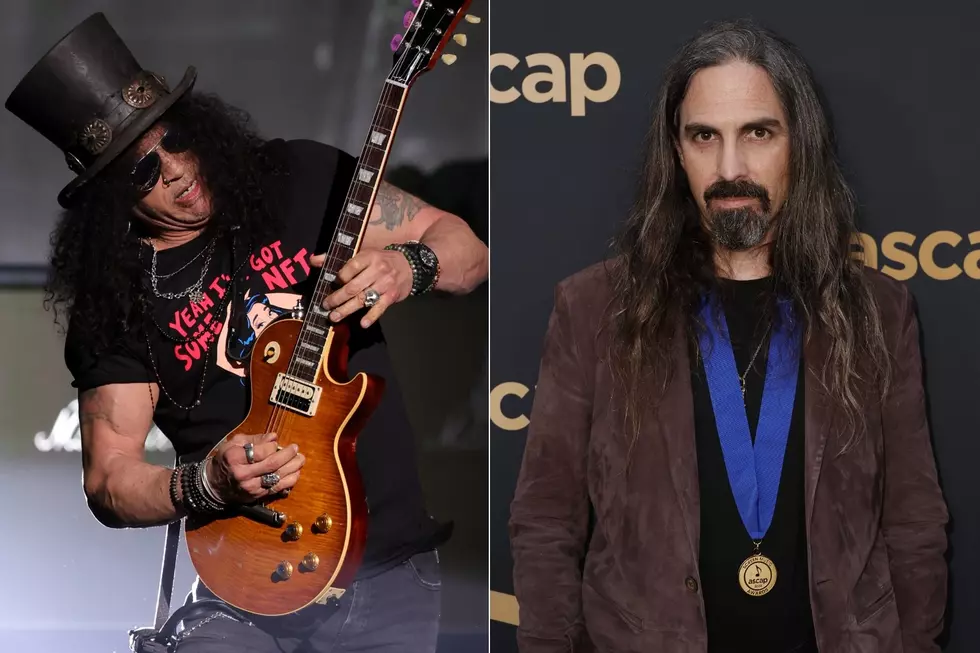
clock This article was published more than 10 years ago
The Beatles’ first U.S. concert: An oral history of the day the Fab Four conquered D.C.

On Feb. 11, 1964, Beatlemania blasted Washington — all shrieks and Arthur haircuts and songs people couldn't quite make out.
Two nights after their hysteria-inducing welcome-to-America appearance on "The Ed Sullivan Show," the Beatles played their first U.S. concert at the Washington Coliseum. With "I Want to Hold Your Hand" sitting atop the American Billboard chart, 8,092 people crowded into the arena near Union Station and witnessed the band perform a dozen songs that changed everything.
"It was one of the most exciting live performances the Beatles ever gave," says Beatles historian Bruce Spizer, who has studied footage of the concert at the long-defunct Coliseum. "And it gave them great confidence that they indeed could conquer America."
Here's the tale of the historic 1964 visit, as told by some of the people who lived it.
John B. Lynn, son of Harry Lynn, who owned the Coliseum : My father got the call asking if he'd be interested in having the Beatles. He, of course, had never heard of them. But he said yes. He brought home a box of Beatles albums and singles to give out, and my brother and I became the most popular people in school.
Paul McCartney : We'd seen a lot of British stars come back from America with their tails between their legs. We made a promise to ourselves to not go until we had a No. 1. We were so excited to be madly popular in America, which was to us the Holy Grail because every shred of music we ever loved came from there. It was euphoric, and now we were heading to Washington on the train, which was very glamorous. And to cap it off, there was that beautiful snow.
Bill Eppridge, former contract photographer for Life magazine who died in 2013 : We were going to fly down from New York, but a big snowstorm hit Washington. The Beatles reserved a couple of cars on the train and got tickets for the press traveling with them. I couldn't have had a better time. We all liked them. They were always looking for something to do. They had a race up and down the car, and two of them went up and over the seats and two of them crawled in the baggage racks. And then they grabbed the waiters' uniforms and served drinks.
Albert Maysles, documentary filmmaker ("What's Happening! The Beatles In the USA," "The Beatles: The First U.S. Visit") : All kinds of funny things happened on the train. They were behaving for the camera. Ringo carried some camera bags and worked his way through the coach. They were strangers in a new land, enjoying that kind of fresh experience. I remember a child meeting Ringo and the conversation they had, which was so endearing.
Linda Binns Liles, train passenger on Feb. 11, 1964 : My family was riding back [to Richmond], and we happened to be in the only car that got to see the Beatles. They walked through and gave autographs. I was like, "Well, I got two of their autographs; I think I need all four." I was 9 years old, not a crazy teenager — when we stopped at stations, there were teenagers jumping up and down, trying to look in the windows — so I was able to get back there. I introduced myself to Ringo Starr and promptly sat down and started talking with him. "You went to New York for the first time? So did I." We had a normal conversation. I was sure he was interested in my fourth-grade teacher as much as I was interested in what he was doing. Paul McCartney, who had me calling him Uncle Paul, asked me if I was coming to their D.C. concert, and I was like, "No, I've got to go to school tomorrow." I was perfectly serious.
Lynn : My father wasn't in the habit of meeting his acts when they arrived in town. But he met the Beatles. He had been stationed in Liverpool during the war, so I think he might have felt some connection to them. He didn't expect the crowd — especially on a snowy day.
Maysles : There was an enormous crowd waiting when we got to Union Station.
McCartney : It was unbelievable, a great sort of validation of the whole thing. It was like, "Yeah, look! Everywhere we're going in America, it's happening!"
Marsha Albert, who persuaded WWDC-FM deejay Carroll James to play the Beatles on Washington radio in late 1963 : There was no school that day because of the big snowstorm. So I went down to Union Station and WWDC got me onto the platform when the train came in. The Beatles got into one car and I got into another. Somehow, I was in the limo with John Lennon's wife and George Harrison's sister.
Tommy Roe, "Sheila" singer : In 1963, I was booked in England with Chris Montez, and the Beatles were a featured act on our tour. It was like Elvis Presley all over again. Brian Epstein, the Beatles' manager, had called my manager and put me on the Washington, D.C., show. I was really happy to do the show with them. We were all staying at the Shoreham Hotel, and I tried to hang out with the boys there, but it was pandemonium. I'd already experienced it in England, so I knew it was going to happen in America.
Phil Hollywood, former general manager of the Shoreham Hotel : We sealed off an area of the hotel so they wouldn't be harassed or bothered. The elevator operators were instructed not to go to their floor, and Capitol Records provided security in the stairwell. But the kids were roaming around, trying to get to the Beatles. It was nonstop. They tried to bribe a maid for a maid's uniform and some of them laid down in the elevators and said they weren't getting off until they went to the Beatles' floor. Security lifted them off the elevator and told them to calm down. We brought the band up to the Presidential Suite in a service elevator. They were very polite, down-to-earth boys, but I think they were overwhelmed by what was happening.
Al Gore : The incredible phenomenon built on itself. The "Ed Sullivan" appearance just prior to their arrival in Washington was electrifying. We could scarcely believe the Beatles were coming to D.C.
Reed Hundt, former Federal Communications Commission chairman : Everybody our age knew about them. How could you not? Gore and I were juniors at St. Albans. We weren't even 16 until the next month, and the Beatles were singing, "she was just 17." We were thinking, "Well, that's too old for us."
A lbert : I ended up at the arena, where the Beatles were having a press conference. I went out to the radio station trailer where they were doing an interview with Carroll James. He called me in and told them that I was instrumental in getting him to play their record, so they thanked me. I didn't really say much. They were still in the process of being interviewed. Plus, I was 15 years old. You know what it's like to be 15.
Mike Mitchell, photographer : I was 18 years old and was a burgeoning freelance photographer. When I heard the Beatles for the first time, on the radio in my '55 Chevrolet, it was a magical moment. I realized immediately that I wanted to be a part of whatever was going to happen here with their concert. I called a freelance client and asked if they could get me press credentials, which they were able to do. But they had no desire for photographs of the Beatles in their magazine, because they were part of the "grown-up" press establishment. I was on my own, to do whatever I wanted to. I spent most of the day at the Coliseum.
Ron Oberman, former Washington Star music columnist : They had a press conference at the Coliseum before the show, with all four Beatles in a boxing ring that became the stage. I asked George if he had a girlfriend. He said: "Yes, you, love." I was doing one of the first regular columns on rock in a newspaper, and I was only 20, 21. The older people at the press conference didn't get it.
McCartney : The press conferences were quite funny. It was always: "Hey, Beatles, is that hair real, or is it a wig?" Well, that's a very good question, isn't it? How dumb are you? But we didn't mind it at all. We expected it. It was a completely different world. It's not like now where you'll find all these kids writing for the Internet. It was elderly, balding gentlemen who smoked a lot — grown-ups looking disapprovingly at the children having too much fun. We knew it wasn't hard to beat that kind of cynicism. It was like a chess game. And the great thing was, being four of us, one of us could always come up with a smart-ass answer.
Eppridge : These guys were so quick and genuinely funny. They had a great sense of humor. They really knew how to handle the press.
Roe : The concert was a big deal. It was an amazing scene. They were really catching on and everybody came to that show, either hanging out backstage and trying to become the fifth Beatle or trying to get on the bill. They kept adding people. The marquee didn't say anything about the other acts. It just said "The Beatles." It was all about them. But I wasn't offended. That's just the way it worked. I was there to do my two songs and then get off the stage.
McCartney : We were always slightly sort of embarrassed when the promoters laid too heavy an emphasis on us. We were quite democratic about it. Sure we wanted our name big and stuff, but we always liked the others to get a mention.
Lois Lane, of the "You Don't Have to Be a Baby to Cry"-singing Caravelles : We were asked to appear with the Beatles in Washington, and we sort of knew what to expect, because we'd been on a concert with them in Scotland at the end of 1963. We knew it was going to be mayhem and lots of shouting and screaming. When we went on, we got some of that screaming from the girls, too, I think by association, because we also came from England. But we were all sort of incidental, weren't we? We just happened to be there for a time, to keep the crowd quiet for a while before the Beatles. It was the beginning of that "boy band" type of thing, really. It was exciting.
Lynn : My father had run one ad in the paper, and the concert sold out. He was so stunned that a group he'd never heard of before sold out. It was such an unusual event and it was a windfall. He took the profit and used it to buy my mother a new Lincoln Continental convertible for her birthday. We came home from school and he said, "The Beatles concert bought that for your mother."
Hundt : I think I still have the ticket somewhere. It was not very expensive — $2.50 or something like that. And it wasn't like tickets were hard to get.
Larry Sealfon, former record-store clerk : I was working at Super Music in Silver Spring, and we were allocated a block of tickets to sell. But there wasn't a frenzy or anything like that. It was pretty orderly. After the concert, people came in — mostly mothers — complaining about their seats. They complained that all they got to see was the back of the Beatles.
Albert : The stage was in the middle of the arena and the band had to rotate around the stage. So they were only facing you a quarter of the time. The rest of the time you were either looking at their backs or their sides. That wasn't ideal.
McCartney : That was the first time we'd ever played in the round. We said: "Do we have to do it?" "Yeah. We've sold tickets everywhere. You'll have to turn around." How the hell are we doing to do that? "Well, just do a few numbers east then shuffle around north. Then do a few numbers north and shuffle around west." We said: "What's Ringo doing to do?" He had to shuffle the [drum] kit around himself. The idea that we had our backs and sides to three-fourths of the audience at any point of the show was awkward. We were used to getting them and holding them — paying attention to them and having them pay attention to us. There were a few things we did once with the Beatles, and playing in the round in Washington was one of them. I don't think I've done the in-the-round thing ever since.
Lynn : They wanted to fit as many people as possible in. If they had played with the stage at one end, they would've only been able to fit 6,000 or 6,500. With the stage in the middle, they could fit 8,000.
Hundt: It was mostly girls. Being from a boys school, we had never seen so many girls in one place before. I don't know that I knew for sure that there were that many girls in the world.
McCartney : It was terrific. We'd been used to it in smaller doses. But in our minds, it's only right that it should get bigger. And where better for it than America, where everything is bigger? It was very exciting, just having that many people — predominantly girls, all screaming.
Albert : I never was a screamer. It was all about the music for me. The concert started with some warm-up groups, and I was relieved because I had heard about the screaming that went on in England. And I thought: Nobody's screaming. This is going to be nice; we're going to be able to hear them. (Laughs.) When they started playing, you couldn't hear a thing. It was unbelievably loud, like white noise. I remember the policeman near me stuck bullets in his ears.
Eppridge : That's probably where I lost most of my hearing. Either there or with the Marines in Vietnam, AR-15s cracking next to my ear. I remember my ears hurting from the high-pitched screaming for the Beatles. It was absolutely piercing. If you're around six railroad train engines and they're all traveling at 100 miles an hour and they slam on their brakes at the same time — that's what it sounded like. But it was delightful.
Gore : The acoustics in the arena combined with the absolute frenzy of enthusiasm made it virtually impossible to understand a single word that they sang. You had to listen carefully to get the general flow of the song, and of course everybody knew all the words prior to the concert. We all loved their music, but clearly there were a lot of people in that crowd who loved it even more than I did because they couldn't stop screaming. I'm thrilled that iTunes [got] the film of that concert, because I'll get to hear the words clearly for the first time.
McCartney : Opening with "Roll Over Beethoven" wasn't a statement. Every time we did shows, we did the same as I do now: You just feel the climate; you put your finger in the air and whichever side goes cold is the way the wind's blowin'. We didn't plan those things. It was just: "Let's start with George doing 'Roll Over Beethoven.' It's rockin'." In retrospect, I should be telling [that] it was a calculated move to show the world of classical music that it was time they rolled over and made way for the delightful young sound that's going to take over.
Mitchell: I was on the side they were facing, right up against the stage, in front of Lennon. I could feel something momentous happening; it was definitely the most dramatic thing I'd both ever experienced and ever photographed. My principal memory is that I was in a very heightened state of alertness, so incredibly focused. But I've seen the footage, and there are times I'm leaning on the stage, just taking it all in. I've realized in subsequent years what a tremendously privileged perspective I had. I could even hear the music and the lyrics.
Oberman : It was a short set, like 35 minutes. I was able to hear some of the songs with some difficulty. I thought they were excellent.
McCartney : I don't remember thinking we played particularly well. But looking back, time has been very kind to us. It was a cool gig.
Lynn : I didn't think of it as something I should always remember. I just thought it was a fun time. But one thing I'll never forget is that my friend was already wearing a black Beatles wig. I don't know how that got going so quickly.
Maysles : No one gave us permission to bring the camera in, so we had to sneak into the arena. We would've liked to have gotten close to the stage, but we took our seats at some distance. At one point I saw that sitting just behind us was Brian Epstein, who was enjoying the whole performance. And it turned out I had probably a better view than had I been close up, because I could [film] very wide and include the young audience, which was just going crazy with joy.
Lynn : This is kind of gross, but somebody said — and maybe it was my father — that after the concert was over and everybody had left, you know what the smell was in the Coliseum? It was pee from all these girls who got over-excited.
Roe : This was early in the crazy rock-and-roll thing, so nobody really rushed the stage. They were rowdy and very loud, but they stayed in their seats. They hadn't realized you can go berserk at these shows. It was like polite pandemonium.
Gore : "Polite pandemonium" is apt. At the time, we didn't think anything unusual about the first part of that phrase. What was unusual was the second part.
Albert : There was a large police presence there, but since everybody was so well-behaved, they didn't have much to do except stand around. But people were throwing stuff. Since we were down front, we were getting pelted with flashbulbs the size of golf balls and also jelly beans.
McCartney : We had been asked somewhere what is your favorite sweet, and we said jelly babies. So the fans took to throwing them onstage, and this had reached Washington. In England, they're soft and always in the shape of babies. What do you call them? Jelly beans. They're hard. They stung, and we're playing in the round, and they're being thrown from everywhere. It was very unsettling. After that, we said the time has come for us to tell people we hate these damn things. They were only trying to be cute; throw the cute bits at the cute boys, that will be fun. But if you caught one of those in the eye, that was none too pleasant.
Hundt : We came armed and threw jelly beans at Ringo's cymbals. I think you can hear them pinging on the tapes of the concert. It probably was a bad thing to do, but there was some story that the Beatles liked them, and high school boys like to throw things. So that's how they were welcomed.
Gore : I don't recall throwing any jelly beans myself. But I know that all around us, there were lots being thrown. It wasn't intended in a malicious way.
Albert : The show was somewhat disappointing. I mean, it was exciting in one way. Yeah, I got to see them. But there was all this interference — the noise, and all the stuff raining on us.
Mitchell : When they did the last lines of the Little Richard song, ["Long Tall Sally"], they were gone in a flash. The crowd felt a little turbulent, so I jumped onto the stage. But when I looked around, I saw how young everybody was and realized there was no threat to my life at all. At that point, I turned into a fan. I lingered around Ringo's drumsticks, long enough to slide one under my coat. I felt guilty about it immediately. That thing eventually got given to a girlfriend's little sister, in an effort to impress the girlfriend. I tracked her down a few years ago but the souvenir has disappeared.
Gore : A friend of ours and classmate actually made some good money selling photographs after the event. He had a business plan: He took as many photos as possible and posted them on the bulletin board at school after the concert, and they were snapped up like hotcakes.
Roe: After the show was over, I drove back to the Shoreham and went to the Beatles' room and we had a beer or two and just chatted. But it was hectic. Everybody was trying to do interviews with them. I helped Murray the K get in there and tape an interview with them.
McCartney : I'm sure we got [annoyed] not being able to just enjoy ourselves and always having to answer some dumb question about this, that and the other — like what toothpaste we were using. We saw ourselves as sophisticated dudes in those days, and there was a little bit of irritation at the undue attention we were getting. But at the same time, we asked for it. We knew what it was.
Eppridge : There was a reception afterwards hosted by British Ambassador David Ormsby-Gore, and it was not exactly what I expected. You expect people at an embassy party to stand around in dark suits holding champagne glasses. It's supposed to look regal and dignified. The reception was absolutely jampacked with teeny-boppers and musical people, with an awful lot of Americans. It was a strange group. The British charge d'affaires was wearing a Beatles wig.
McCartney : The idea of going to an ambassador's party was sort of amusing and vaguely interesting, but it wasn't our scene. It was a little too aristocratic. It was a little jolly hockey sticks. "Oh, the Beatles, how delightful! How amusing!" Yeah, all right, love. Then one of these debutantes came up with a pair of scissors and tried to snip our hair, like she was walking up behind some mannequins. Okay, time to leave! We knew we were famous and up for grabs, but that was most definitely out of order. Finally somebody had crossed the line, majorly. It was unfortunate. But the great thing about memories is that the good bits are the ones that tend to remain. The trip to Washington is a very romantic time in my memory.
A shorter version of this account was published in The Washington Post in 2010, when Paul McCartney returned to Washington for the Kennedy Center Honors. Some quotes have been condensed. Staff researcher Magda Jean-Louis contributed to this report.

- History Classics
- Your Profile
- Find History on Facebook (Opens in a new window)
- Find History on Twitter (Opens in a new window)
- Find History on YouTube (Opens in a new window)
- Find History on Instagram (Opens in a new window)
- Find History on TikTok (Opens in a new window)
- This Day In History
- History Podcasts
- History Vault
This Day In History : February 7
Changing the day will navigate the page to that given day in history. You can navigate days by using left and right arrows
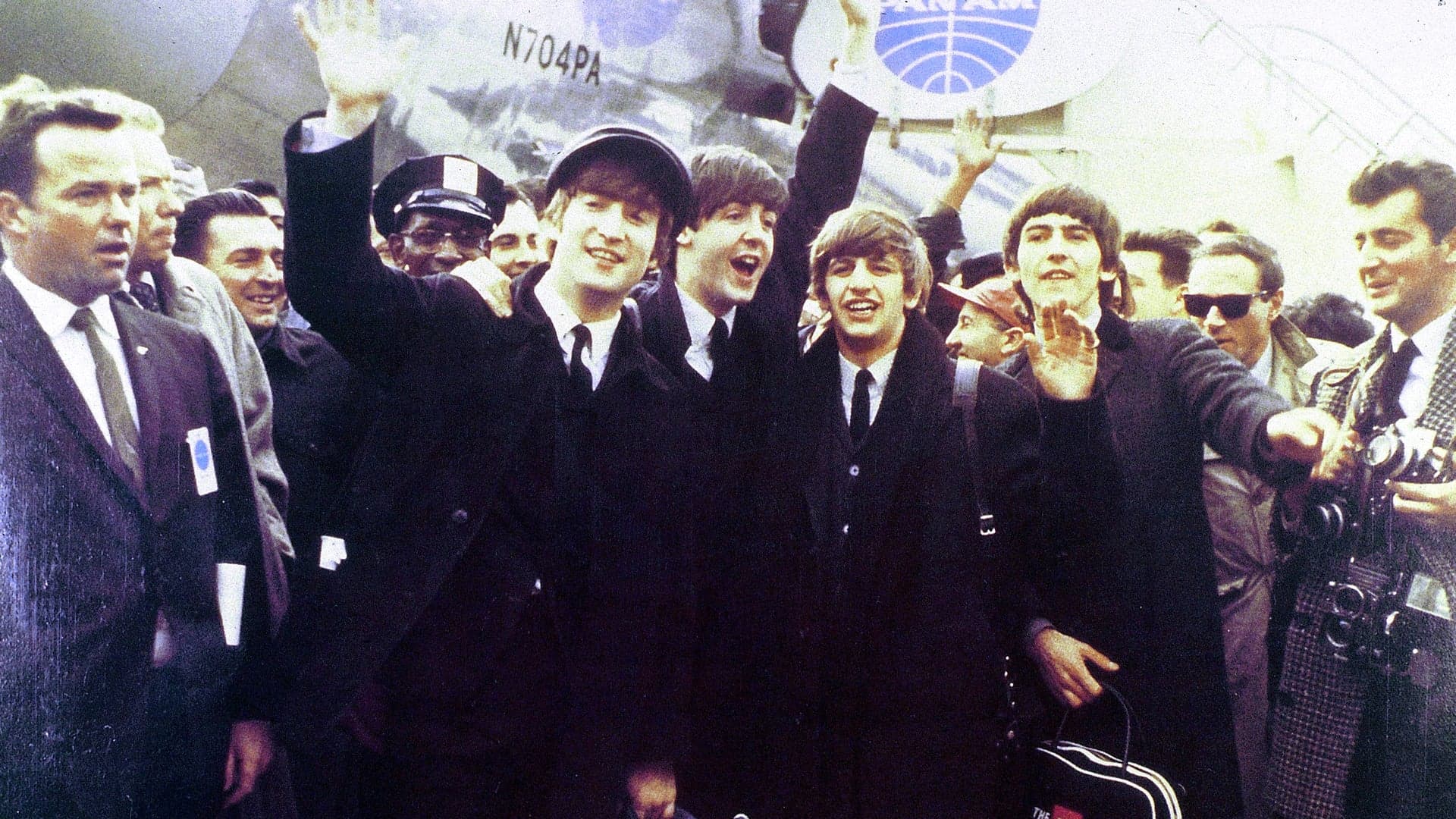
The Beatles arrive in New York
On February 7, 1964, Pan Am Yankee Clipper flight 101 from London Heathrow lands at New York’s Kennedy Airport—and “Beatlemania” arrives.
It was the first visit to the United States by the Beatles, a British rock-and-roll quartet that had just scored its first No. 1 U.S. hit six days before with “I Want to Hold Your Hand.” At Kennedy, the “Fab Four”—dressed in mod suits and sporting their trademark pudding bowl haircuts—were greeted by 3,000 screaming fans who caused a near riot when the boys stepped off their plane and onto American soil.
Two days later, Paul McCartney , age 21, Ringo Starr , 23, John Lennon , 23, and George Harrison , 20, made their first appearance on the Ed Sullivan Show, a popular television variety show. Although it was difficult to hear the performance over the screams of teenage girls in the studio audience, an estimated 73 million U.S. television viewers, or about 40 percent of the U.S. population, tuned in to watch. Sullivan immediately booked the Beatles for two more appearances that month. The group made their first public concert appearance in the United States on February 11 at the Coliseum in Washington, D.C., and 20,000 fans attended. The next day, they gave two back-to-back performances at New York’s Carnegie Hall, and police were forced to close off the streets around the venerable music hall because of fan hysteria. On February 22, the Beatles returned to England.
The Beatles’ first American tour left a major imprint in the nation’s cultural memory. With American youth poised to break away from the culturally rigid landscape of the 1950s, the Beatles, with their exuberant music and good-natured rebellion, were the perfect catalyst for the shift. Their singles and albums sold millions of records, and at one point in April 1964 all five best-selling U.S. singles were Beatles songs. By the time the Beatles first feature-film, A Hard Day’s Night, was released in August, Beatlemania was epidemic the world over. Later that month, the four boys from Liverpool returned to the United States for their second tour and played to sold-out arenas across the country.
Later, the Beatles gave up touring to concentrate on their innovative studio recordings, such as 1967’s Sgt. Pepper’s Lonely Heart’s Club Band, a psychedelic concept album that is regarded as a masterpiece of popular music. The Beatles’ music remained relevant to youth throughout the great cultural shifts of the 1960s, and critics of all ages acknowledged the songwriting genius of the Lennon-McCartney team. In 1970, the Beatles disbanded , leaving a legacy of 18 albums and 30 Top 10 U.S. singles.
During the next decade, all four Beatles pursued solo careers, with varying success. Lennon, the most outspoken and controversial Beatle, was shot to death by a deranged fan outside his New York apartment building in 1980. McCartney was knighted by Queen Elizabeth II in 1997 for his contribution to British culture. In November 2001, George Harrison succumbed to cancer . Ringo Starr was knighted himself for "services to music" in 2018.
Also on This Day in History February | 7

Guests watch Mel Brooks' "Blazing Saddles" movie premiere from horseback
Full u.s.-cuba embargo is announced, this day in history video: what happened on february 7, the great baltimore fire begins, navy captain becomes the first human to perform an untethered space walk, european union treaty signed.

Wake Up to This Day in History
Sign up now to learn about This Day in History straight from your inbox. Get all of today's events in just one email featuring a range of topics.
By submitting your information, you agree to receive emails from HISTORY and A+E Networks. You can opt out at any time. You must be 16 years or older and a resident of the United States.
More details : Privacy Notice | Terms of Use | Contact Us
President George W. Bush announces plan for “faith-based initiatives”
Earthquake causes fluvial tsunami in the mississippi river, criminal case ends in plea bargain—one of the first, mysterious murder, later solved by forensic evidence, benjamin franklin publishes “an imaginary speech”, josef mengele, known as the “angel of death,” dies, german sub sinks scottish passenger ship ss california.

- Privacy Overview
- Strictly Necessary Cookies
This website uses cookies so that we can provide you with the best user experience possible. Cookie information is stored in your browser and performs functions such as recognising you when you return to our website and helping our team to understand which sections of the website you find most interesting and useful.
Strictly Necessary Cookie should be enabled at all times so that we can save your preferences for cookie settings.
If you disable this cookie, we will not be able to save your preferences. This means that every time you visit this website you will need to enable or disable cookies again.
60 years Ago: BEATLES PLAY FIRST CONCERTS IN AMERICA

The Beatles began the week of February 10, 1964, with a series of press conferences at the Plaza Hotel. In addition to answering endless questions, the group received gold record awards for I Want To Hold Your Hand and Meet The Beatles! from Capitol Records, the same label that had previously passed on issuing the group’s records in America an incredible four times. They also met with David Picker of United Artists to discuss their upcoming film and attended a cocktail party held in their honor.
The Beatles were scheduled to fly from New York to Washington, D.C. on the morning of February 11, but balked at the idea when confronted with a winter snow storm. George made it clear he was not going to fly in a “fookin’ blizzard.” Plans were quickly altered and the Beatles, their entourage and the press boarded a train at Penn Station to head to the nation’s capitol. About 2,000 fans were there to great them when the train arrived shortly after 3:00 p.m. The Beatles were then taken by limos to the Shoreham Hotel, where the group freshened up and worked out the set list for the evening’s concert.
The group was then taken to the site of their evening concert, the Washington Coliseum, where they conducted a press conference from the stage. After walking over to WWDC’s satellite studio located by the venue for an exclusive interview with Carroll James, the disc jockey who played I Want To Hold Your Hand weeks before its scheduled release date, the group returned to the Coliseum.
When the group climbed onto the stage just after 8:30 p.m., fans began screaming and photographers (both professional and amateur) started taking tons of pictures. The Beatles knocked out a high-energy 12-song set, with the adrenaline rush brought on by the screaming crowd causing Ringo to push the beat a bit faster on many of the songs. After recovering from the concert, the group headed to the British Embassy to attend a charity ball.
Having played their first American concert the night before in front of over 8,000 screaming fans, the Beatles awoke in an excited mood. They got a mini-tour of the nation’s capitol and then headed back to New York by train. About 1,500 fans were there for the group’s arrival at Penn Station. The boys were smuggled out of the station through a freight elevator and subterranean passageway. Upon arrival at the Plaza, it was more of the same. After relaxing for a spell in their Plaza Hotel suites, the group headed to Carnegie Hall, where they gave two successful concerts before their enthusiastic fans. Later that evening Murray the K took the group to the Headliner Club, where Ringo twisted the night away. After a stop at the Improvisation coffee house, the group went back to the Plaza at 4:00 a.m.
On Thursday afternoon the Beatles flew to Miami, where they were met by a crowd estimated at between 4,500 to 7,000 people. The group got a police escort to the Deauville Hotel. After dinner and a meeting with the staff from The Ed Sullivan Show , they went to the Miami branch of the Peppermint Lounge, where they caught R&B singer Hank Ballard’s show. They stayed till 1:00 a.m. before having a round of the drunks at the Wreck Bar before heading back to the Deauville.
On Friday, the Beatles did a photo shoot for Life magazine and were taken out on the motor yacht Southern Trail . At 6:00 p.m., the group held a rehearsal in one of the Deauville’s lower level rooms. That evening they went to the home of a Miami Beach policeman who had been serving as their protector and guide. They were treated to a family-style American dinner with his family. After returning to the Deauville at about 11:00 P.M., the group headed to one of the hotel’s night clubs to see comedian Don Rickels, who poked fun at them from the stage.
The next day the Beatles spent the morning fishing and swimming before returning to the Deauville for a camera rehearsal for The Ed Sullivan Show , which was set to be broadcast live from the hotel on Sunday night. That evening, they went to a night club to see the Coasters.
Sunday, February 16, began with a morning camera rehearsal. That afternoon, the group took part in the show’s dress rehearsal in front of 3,500 lucky ticket holders in the hotel’s Napoleon Ballroom. After relaxing in their rooms for a few hours, the Beatles were escorted through the hotel’s crowded lobby to the Napoleon Room for the live broadcast. The group’s second Ed Sullivan Show was another triumph, with approximately 72 million viewers tuning in.
After the show, the hotel’s owner held a party for the Sullivan Show staff and guests. While the other Beatles were in an upbeat mood, Ringo appeared sullen. When asked by Sullivan Associate Director John Moffitt why he was feeling somber, Ringo replied, “It will never be any better than this. It’s all straight down from here.” Ringo would soon learn he was wrong. It would get even better.
The full story of the Beatles in America is told in great detail in the book The Beatles Are Coming! The Birth of Beatlemania in America .
This week’s questions cover the Beatles first concerts in America and their stay in Miami Beach.
- What song did the Beatles choose to open their first American concert?
- What song did the Beatles close their first American concert with?
- What was the Washington Coliseum normally used for?
- What was the name of the sleeper car that they Beatles were in during their train ride from New York to the nation’s capitol?
- Who booked the Beatles into Carnegie Hall?
- Who was the opening act for the Beatles Carnegie Hall concert?
- Who were George’s two different roommates at the Deauville Hotel?
1. Roll Over Beethoven , a Chuck Berry rocker with George on lead vocal. The Beatles version of the song had yet to be released in America.
2. Long Tall Sally , a Little Richard rocker with Paul on lead vocal. The Beatles had yet to record the song for EMI. The concert’s set list is shown below.
3. Boxing and wrestling matches. The group performed on a square stage. The Beatles changed the direction they were facing every three songs so that all in attendance would get a front view of the band for part of the show.
4. The King George , named after a British monarch, not George Harrison or George Martin.
5. Sid Bernstein, who would later promote the Beatles historic concert at Shea Stadium.
6. The Briarwood Singers, a folk group from Miami.
7. Murray the K followed the Beatles down to Miami Beach and roomed with George for a few days before heading back to New York. Afterwards, George was joined by their Miami Beach police escort, Sgt. Buddy Dresner.

Related Posts

Like what you're reading? Subscribe to our top stories.
Leave a Comment Cancel Reply
Yes, add me to your mailing list
Attachment The maximum upload file size: 25 MB. You can upload: image , audio , video , document , spreadsheet , interactive , text , archive , code , other . Drop file here
Privacy Overview
Subscribe to bruce's newsletter.
Receive discounts, news about sales, new articles, and much more...
The Beatles live: Washington Coliseum, Washington, DC
The Beatles’ first US concert was watched by a crowd of 8,092 fans at the Washington Coliseum in Washington, DC.
The band had traveled from New York to Washington, DC early in the day by rail, as an East Coast snowstorm had caused all flights to be cancelled.
A special sleeper carriage was attached to the Congressman, the Pennsylvania Railroad express train. The carriage was called The King George, and was already full with press people by the time The Beatles boarded.
Originally, we were going to fly to Washington, but, because of the heavy snow storm that I was told was coming, I advised Brian Epstein to make special arrangements to get a special train to take us to Washington. We went down to Washington and had a lot of fun on the train but we almost got killed when we got off the train. Some 10,000 kids had broken through the barriers. I remember being pinned against a locomotive on the outside, and feeling the life going out of me. I said to myself, ‘My God! Murray the K dies with an English group!’ George looked at me and said, ‘Isn’t this fun?’ I did my show that night direct from their dressing room.
Upon arrival at Washington’s Union Station The Beatles were greeted by 2,000 fans who braved the eight inches of snow on the ground. They gave a press conference before visiting WWDC, which had been the first US radio station to play a Beatles record.
The group and their entourage checked in at the Shoreham Hotel, where they took the entire seventh floor to avoid fans. One family refused to be relocated so the hotel staff cut off the hot water, electricity and central heating, telling them there was a power failure and they had to move.
The Beatles’ concert that night was at the Washington Coliseum, a boxing arena. Upon their arrival at the venue the group held a press conference.
Also on the bill at the Coliseum were The Chiffons and Tommy Roe. However, The Chiffons were unable to make it due to the previous day’s snowstorm. Instead, the opening acts were Jay & The Americans, The Righteous Brothers and Tommy Roe.

The Beatles took to the stage at 8.31pm, and performed 12 songs: ‘Roll Over Beethoven’ , ‘From Me To You’ , ‘I Saw Her Standing There’ , ‘This Boy’ , ‘All My Loving’ , ‘I Wanna Be Your Man’ , ‘Please Please Me’ , ‘Till There Was You’ , ‘She Loves You’ , ‘I Want To Hold Your Hand’ , ‘Twist And Shout’ and ‘Long Tall Sally’ .
The group were performing in the round, and Ringo Starr ’s drum riser was turned 180 degrees after the third song by Mal Evans , to allow the audience behind them to watch the performance. This was repeated again after I Wanna Be Your Man, and following She Loves You they turned 45 degrees.
In addition to this somewhat awkward set-up, George Harrison’s microphone wasn’t working during the opening song, and he was given a faulty replacement. It didn’t dampen the audience’s appreciation, however; they responded with typical screams of Beatlemania, causing one of the 362 police officers present to block his ears with bullets.
Many of the fans pelted The Beatles with jelly beans, after a New York newspaper had reported The Beatles discussing their liking for them.
That night, we were absolutely pelted by the fuckin’ things. They don’t have soft jelly babies there; they have hard jelly beans. To make matters worse, we were on a circular stage, so they hit us from all sides. Imagine waves of rock-hard little bullets raining down on your from the sky. It’s a bit dangerous, you know, ’cause if a jelly bean, travelling about 50 miles an hour through the air, hits you in the eye, you’re finished. You’re blind aren’t you? We’ve never liked people throwing stuff like that. We don’t mind them throwing streamers, but jelly beans are a bit dangerous, you see! Every now and again, one would hit a string on my guitar and plonk off a bad note as I was trying to play.
Brian Epstein had allowed CBS to film The Beatles’ performance, which was shown by the National General Corporation in a telecast in US cinemas on 14 and 15 March 1964. The performance has since been released on DVD, and extracts were included in Anthology.
After their performance The Beatles attended a reception at the British Embassy, at the invitation of Lady Ormsby-Gore. They gave out raffle prizes – signed copies of Meet The Beatles! – at the end of a dance to benefit the National Association for the Prevention of Cruelty to Children, and mingled with the assembled dignitaries.
However, they left in disgust after one of the guests cut off a lock of Ringo’s hair from behind his left ear. The Beatles walked out and told Brian Epstein never to subject them to such an occasion again.
People were sort of touching us as we walked past, that kind of thing. Wherever we went we were supposed to be not normal and we were supposed to put up with all sorts of shit from lord mayors and their wives and be touched and pawed like A Hard Day’s Night only a million more times. At the American Embassy, the British Embassy in Washington, or wherever it was, some bloody animal cut Ringo’s hair, in the middle of… I walked out of that. Swearing at all of them and I just left in the middle of it.
Also on this day...
- 2010: All You Need Is Love to be released as a Beatles Rock Band download
- 1972: Wings live: Hull University
- 1970: Plastic Ono Band perform Instant Karma! on Top Of The Pops
- 1970: New York première of The Magic Christian
- 1970: Recording, mixing: I’m A Fool To Care by Ringo Starr
- 1968: Recording, mixing: Hey Bulldog
- 1966: UK single release: Woman by Peter And Gordon
- 1965: Ringo Starr marries Maureen Cox
- 1963: Recording: Please Please Me album
- 1962: The Beatles live: Casbah Coffee Club, Liverpool
- 1961: The Beatles live: Cassanova Club, Liverpool
- 1961: The Beatles live: Lathom Hall, Liverpool
Want more? Visit the Beatles history section .
Latest Comments
To see clips of this historic concert is pure heaven as The Beatles are showered in adoration from their newly cultivated American fans. But… when is Apple Corps. going to obtain use of the pristine CBS master videotape of this entire show for dvd release?! You can see a short tantalizing clip of it in Anthology and it looks like it was caught on camera just yesterday it’s so crip and clear. I’d lay down the money for it in a heartbeat so come on folks at Apple, please get on this!
Neither The Chiffons or Tommy Roe performed at this show. Both were unable to make it because of the massive snowstorm the day before.
The only originally scheduled act to show up were The Caravelles. Also opening up that night were Jay & The Americans and The Righteous Brothers.
Funny; Tommy Roe seems to remember it and has talked about it in many interviews over the years. (And, no – he’s not talking about the UK tour the previous year. He mentions that and then talks about the DC concert). Example:
https://www.washingtonpost.com/entertainment/music/the-beatles-first-us-concert-an-oral-history-of-the-day-the-fab-four-conquered-dc/2014/02/10/23f1042a-9010-11e3-84e1-27626c5ef5fb_story.html?utm_term=.fbaae116f17a
Are you sure about Tommy Roe? I must say I’ve never heard that Jay & the Americans or the Righteous Brothers were among the opening acts. The Chiffons, Tommy Roe and the Caravelles yes, though.
Here’s another link. Now, let’s end this stuff…. https://web.archive.org/web/20220212225311/https://www.houstonchronicle.com/life/columnists/hoffman/article/Tommy-Roe-remembers-Beatles-first-U-S-concert-5222415.php
WWDC was not the first US radio station to play a Beatles record. That honor goes to Chicago’s WLS & legendary DJ Dick Biondi, who aired an original Vee-Jay (with the mis-spelled ‘Beattles’) pressing of “Please Please Me” on his 9-Midnight show soon after its original US release in early 1963. It even made the local charts, on the WLS ‘Silver Dollar Survey’ (Biondi was also the featured DJ on that week’s survey).
For me, the weekend that the Beatles landed in the USA was very personal for more than the usual reasons. In retrospect the entire affair remains bittersweet because I lost a family member. For two months the U.S. had remained in mourning after the assassination of President John F. Kennedy a few weeks earlier on November 22, 1963. Although I was a bit too young at the time to realize the full effects of what was happening in America. I now understand that the death of JFK meant also the death of a dream for much of the youth of the age. Shock and disbelief were the initial reactions of all, followed by a new dark paranoia for much of the newly disaffected youth, a fear fueled by disgust and distrust, and cold uncertainty. On Friday, February 7, 1964, there seemed to be some relief on the way as I watched the Fab Four (on our small black and white TV set in Raceland, Kentucky) land in America. For weeks I had been seeing ads on TV stating that “The Beatles Are Coming!” even though I had no idea what a “Beatle” was. The Fab Four touched down in America, launching the “British Invasion,” all three networks covered their frenzied arrival at JFK Airport where over thousands of fans (estimates run between 3,000 to 4,000) smiled, waved, swooned, and screamed. Many held signs professing their undying love, others offered tokens of love letters, candy, flowers, and photos. It was real and genuine hysteria, and not a publicity stunt, making it a true media event that was also real, unlike much of today’s scripted “reality” shows and staged events. It stands as an historical day not just for music, but culturally for the way that all things English would affect the US youth. Accompanying them was producer Phil Spector who would later work both with them on LET IT BE and with John for some solo material; and Brian Epstein, the group’s personal business manager and impresario who taken them out of the sweaty, gritty beer-halls of Germany and Liverpool and groomed them for the world stage by making good on his promise to take the lads to the States after they landed their first US #1 hit. The brisk sales of “I Want To Hold Your Hand” helped to make it all possible. They made a few humorous remarks to the press and were whisked away to their hotel for the remaining day. On the following morning of Saturday, February 8, 1964, a televised press conference was held with THE BEATLES in the Baroque Room at New York’s Plaza Hotel during which the lads’ warm personalities playfully and quick-wittedly quipped and joked, helping to charm their way into the hearts of their interviewers and America at large. Later, they rehearsed (un-televised) for their first of two consecutively scheduled Sunday night headline appearances on the Ed Sullivan Show. That same Saturday morning, my grandfather John Milt Davidson Sr. did not wake up for breakfast. Grandma (beside him in the photo) had died just before I was born so he had been staying with us for a while. My Mother checked on him and had to tell my Dad that he was unresponsive and cold to the touch. In a panic, Dad rushed into the bedroom where Grandpa slept and realized that his father and namesake had passed away quietly in his sleep after having turned 84 on January 22. Oblivious to what was happening, I was quickly pushed in front of the TV while they called an ambulance and tried to deal with the situation without upsetting me. I recall being absorbed by the Beatles’ interviews, but when a big white truck pulled into the driveway and two men dressed in all white carried a white cot with a white sheet into Grandpa’s bedroom only to bring it back out with him on it a few moments later covered by the white sheet, I was shocked and ran into my Mother’s arms. I asked my Dad “Where are they taking Grandpa?” and I’ll never forget his red-eyed answer: “They’re taking him to heaven, son.” I immediately thought that the men must be angels and I asked my parents if I could go with them. Dad replied, “You’ll see him again someday if you stay a good boy.” Grandpa had been especially fond of me. At Christmas he would hide an extra bag of nuts in the top of his bedroom closet along with an old glass pop bottle to crack them open with. He and Dad would take turns reading to me and sometimes we’d just listen to the radio together if there was nothing on the tube, an event Mom and Dad often enjoyed as well having been raised on radio themselves. That day is now and forever burned into my memory, but it would be years later (I wasn’t quite three yet with my birthday being in May) before I realized the symbolism of it all: my Grandpa’s generation was giving way to the next. Now, 50 years later, Mom and Dad are gone too, and only Paul and Ringo remain of the mop tops, but I must say that they ALL had a profound effect on this music lover. Thanks for letting me share my memories.
WRONG! There are (3) Beatles still alive: Pete Best, (drummer 1960-62), Paul and Ringo.
Some notes to this historic first US Beatles concert. There are a multitude of alternative footage available (well, sort of), so having put it all together at home I now have a very different mix of the film, with less audience and more Beatles. 1.Upon entering the stage we can see Paul unfolding a set list and leaving it on top of one of the amps. One of the few times I have seen that. Holland 64 is another, and I think Chicago 65. 2. No song is introduced by John. No wonder many Americans would think of Paul as the band leader later on. 3. It´so wonderfully amateurish. Spinning the drum set around several times is terrible enough, having the musicians do it themselves is just rude. It happens after I saw her standing there, I wanna be your man, She loves you and Twist and shout. 4. When they moved the drums after She loves you, they didn´t bother changing the amps, so I want to hold your hand is played with their amps pointed to another direction. Before the song, Ringo drums a short roll. I don´t think I ever heard him do that between songs at any other time, he always waited for the next number. 5. During All my loving, Paul and George are on the “wrong” side of one another, compared to later shows. 6. Paul refers to Ringo as “our drummer”, which makes it sound like he was a hired extra. It happened many times. 7. During several songs, you can see girls with microphones wired to a reel-to-reel tape recorder. Would be nice to hear those recordings today! 8. Pauls last intro; “We´ve already overrun our time”; yeah sure, like the audience would have been unhappy with another 6 songs! I wonder who decided on the group´s playing time, Beatles, Epstein or the promotor? All in all, it is great that the show was filmed and preserved as it was. A very enjoyable show.
I listen to footage from this concert and you can hear the bass bouncing off the back of the hall!! It makes you realise all the footage we have of early Beatles is really not representative of their live sound. Mostly we get from the PA, ie vocal and a bit of guitar. It’s a shame we can never hear that cavern sound with the big booming bass from the “coffins” built by Adrian Barber. Washington is the nearest I can hear, anybody got any suggestions? Can anybody eq some footage to bring out the bass?
I love the way Paul’s bass kicks in at the beginning of Roll over Beethoven and just drives it heavy. More bass and drums and their vocals are spot on perfect live.
Sorry, I am from Asunción, Paraguay and I do not write english very well, but I want to ask you a question about the Concert at the Washington Coliseum, I read that at the Concert performs Jay and the Americans, Tommy Roe and The R. Brothers, but, what happened with The Caravelles? an English duo that I read in some place, that the girls performs at the Washington Coliseum with the others covers, That it is true?
How was the bald guy helping Ringo and the boys move their gear around? That dude deserves a medal.
I was just remembering the Beatles today and was telling my husband that I saw the Beatles in D.C. in 1964. For a moment he didn’t believe me… He said hardly anyone has seen the Beatles as they didn’t perform for long, especially in the States. Well, I was 10 and living in Bethesda, Maryland. I’d see the Beatles on the Ed Sullivan show and owned the Meet the Beatles album, their first. My mother bought me a ticket and dropped me off. I was pretty independent. Now days, no mother would drop her barely teenage 10-year old daughter off to a concert. But…she trusted me and there I was with a zillion other teenage girls. I swore that I would not be screaming as I had heard about the fans in the UK screaming. Yet, as the Beatles ran out from the underground access onto the floor of the Stadium, every girl in the entire place stood up and started screaming and we all screamed throughout the entire concert!! Non stop screaming and yelling the Beatle of choice. I yelled “George, George, George”, hoping he would hear my cries coming through all of the other cries. Quite an experience I’ll never remember.
I was there too and have the ticket stub to prove it! I was in Row 11. And my Dad dropped me off along with my girlfriend. You’re right that the screaming was non-stop. I had puschased 2 tickets to the show a couple weeks before the concert based on a small ad in The Washington Post and only hearing I Want To Hold Your Hand. Once they were on Ed Sullivan you couldn’t get a ticket. As a huge Beatles fan I attended subsequent concerts in the U.S. including the famous one at Shea Stadium. Unfortunately, I was always in the “nosebleed” seats after that but excited to be there. I now proudly use a coffe mug that says “I Was There” along with the date, the venue, and a list of the songs they performed. Great times!
I’m interested in finding out more about when The Ormsby Gore Family, Alice Ormsby Gore’s Family Hosted The Beatles At The British Embassy in Feburary 1964
Leave a Reply
Beatles Archive
The definitive archive for beatles fans, the beatles’ first concert in the us.
The Beatles’ first visit to the US came at a time of great popularity in Britain. The band’s UK commercial breakthrough, in late 1962, had been followed by a year of successful concerts and tours. The start of the Beatles’ popularity in the US, in early 1964, was marked by intense demand for the single “I Want to Hold Your Hand” which sold one and a half million copies in under three weeks and the band’s arrival the following month. The visit, advertised across the US on five million posters, was a defining moment in the Beatles’ history, and the starting-point of the British Invasion.
On 9 February 1964, the Beatles made their first live US television appearance. 73 million viewers —about two fifths of the total American population— watched the group perform on The Ed Sullivan Show.
Two days after the television appearance, on 11 February 1964, the Beatles’ first US concert took place, at Washington Coliseum, a sports arena in Washington, D.C. The concert was attended by eight thousand fans. The Beatles performed on a central stage in the arena, with the audience on all sides, and there were regular pauses to enable the band to turn their equipment around and perform facing in another direction.
“They played The Ed Sullivan Show, and then they took the train down to DC. That’s where I lived at the time, that’s where my career started. So when they showed up in DC, my sister was assisting their photographer, and she said, “You’d better come see these guys,” so I did.” Rowland Scherman
All photos by Rowland Scherman
Rowland Scherman began taking pictures in New York in 1958, when he was an apprentice at the LIFE darkroom. In 1961, a 24-year old freelancer, he served as the first photographer for the Peace Corps. Scherman travelled the world for the newly-formed organization, helping to give the Peace Corps its image. Scherman has done covers and photojournalism for LIFE, Time, Newsweek, Paris Match, Playboy, and National Geographic.
Related Posts:
2 comments on “ the beatles’ first concert in the us ”.
- Pingback: Beatles at Washington Coliseum, the Mike Mitchell shoots | Beatles Archive
Can’t buy me ❤️
Leave a Reply Cancel reply
Privacy overview.
Share this website
News - 09 February 2016
7th February, 1964 - Beginning of First US Tour
Related articles.
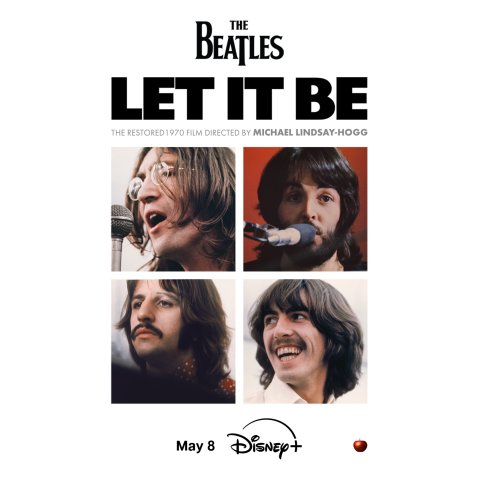

RECENT POSTS
Tributes for allman brothers band legend dickey betts, radio hits of april 1969: how sweet it is, ringo starr adds tour dates in busy 2024, crosby, stills, nash & young’s ‘deja vu’: a volatile chemistry.
- Nitty Gritty Dirt Band Adds Dates to Farewell Tour
- David Bowie ‘Ziggy Stardust’ Era is Celebrated With “Rock ‘n’ Roll Star” Set
- Little Feat Releasing ‘Sam’s Place,’ 1st New Studio Album in 12 Years
- A Rollicking Live Album from Willie Nile: Review
- The Paul McCartney Solo Debut: His Declaration of Independence
- When Don Henley Revealed That Deacon Frey, Glenn’s Son, Was Joining Eagles
- ‘Brush With Greatness’: Rock Fans Share Their Stories
- Rock Hall 2024 Inductees To Be Revealed on ‘American Idol’
- The Beatles ‘Let It Be’ Film Returning After 50+ Years
- Remember Paper Lace and ‘The Night Chicago Died’?
- ‘Louie Louie,’ the Kingsmen and the FBI: Only in America
- Ralph J. Gleason Book Explores the Life & Legacy of a Pioneering Music Critic: Author Interview
- Billy Joel CBS TV Special To Get Rebroadcast After Network Goof
- 10 Times the Beatles Used Pseudonyms on Records
- Willie Nelson ‘Stardust’: Reimagining the American Songbook
- The History-Making ‘Come and Get Your Love,’ From Redbone
LATEST REVIEWS
- Supertramp’s ‘Breakfast in America’
- Bob Seger – Final Tour
- Janis Joplin Biography Review
- CSNY’s ‘Deja Vu’
- Rolling Stones – 2019 Concert Review
- Eric Clapton Celebrates at MSG
- Roger Waters ‘Us + Them’ Tour
- Warren Zevon’s ‘Excitable Boy’
- Tom Petty 40th Anniversary Concert
- 1971: Year That Rock Exploded – Book
- Steppenwolf’s Debut: Heavy Metal Thunder
- ‘Who’s Next’ – Album Rewind
- Privacy Policy
The Beatles’ First American Show: The Gig They Dreamed Of
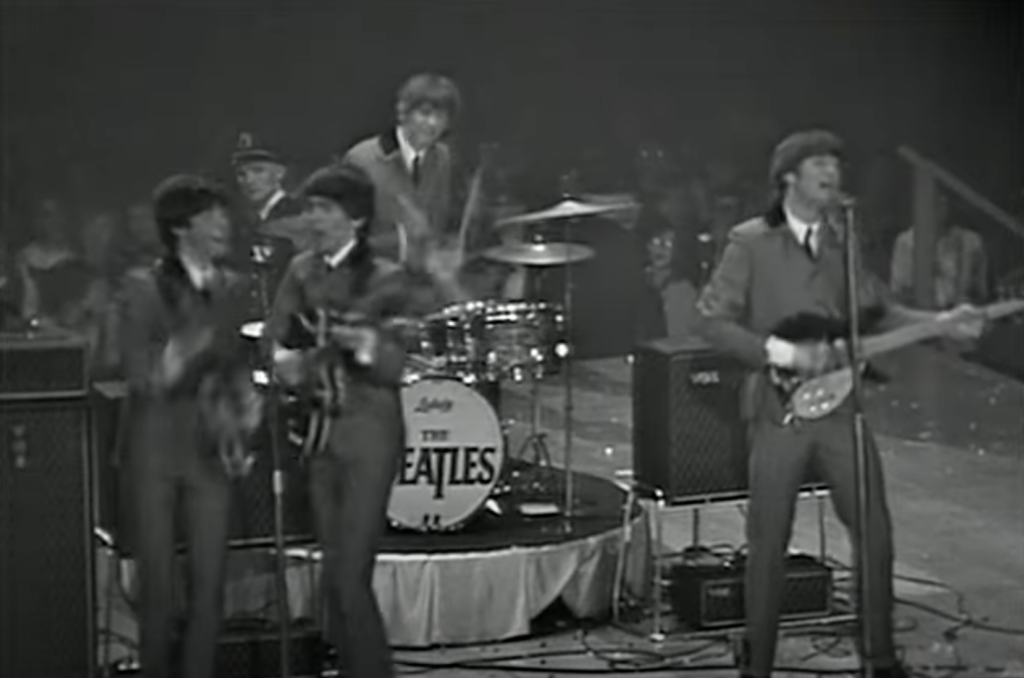
The Beatles in Washington, D.C., Feb. 11, 1964 (YouTube screen shot)
Given that just about everyone who loves rock and roll has a gig they’d love to go back in time to attend, it makes sense that every rock and roll band has a dream show. For The Beatles , that had to have been February 11, 1964, when they performed their first concert in mighty America, a land of cooler-than-cool style, modernist vehicles and all of the rock and roll that actually mattered.
Touching down in the States on February 7, 1964, they played The Ed Sullivan Show on February 9, but that was a TV studio—the stuff of cinematic moments to come in the likes of A Day’s Night . A proper gig in an arena stuffed with fans was something else. And that gig taking place in America’s capital was something else again, the stuff of wildest dreams coming to fruition. There was no way the Beatles weren’t going to give the show of their up-until-that-very-moment lives.
The group traveled from Manhattan to Washington, D.C., the morning of the concert on account of a winter storm halting air flight. They gave a press conference care of WWDC—the station that could now proudly boast being the first in the country to play a Beatles record—and then checked into the Shoreham Hotel.
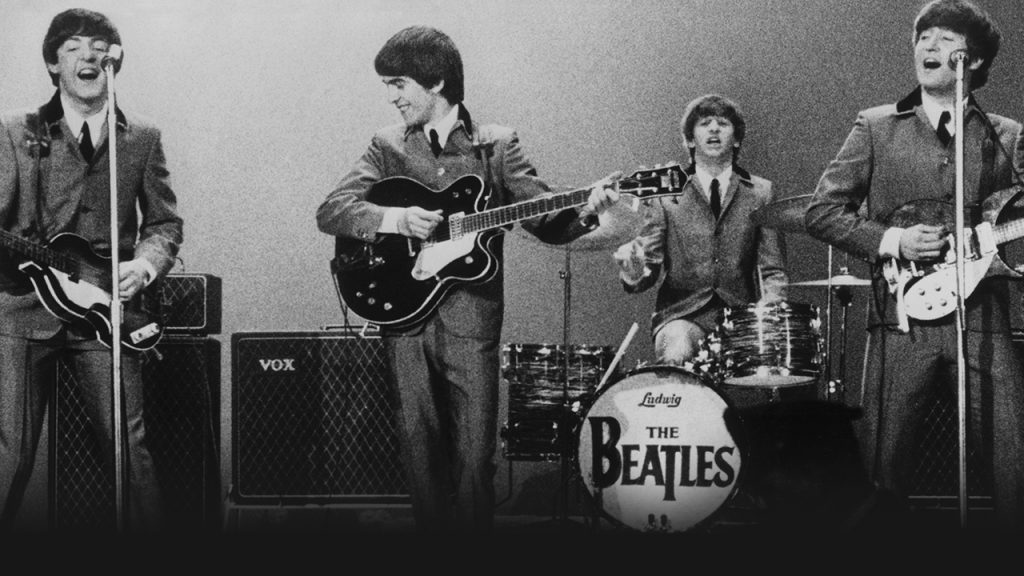
The Beatles at the Washington Coliseum, Feb. 1964, courtesy of Apple Corps Ltd.
It’s difficult to overstate what this day would have meant to these four young men. England, in their view, was a small, sheltered, insular place. Its music studios were not equipped for rock and roll. No rockers that the Beatles themselves listened to came from their foggy, damp isle.
America was where rock and roll was at, a place so big as to be a world unto itself. The Beatles romanticized the States. Ringo Starr had wanted to be a cowboy. George Harrison had designs on being like Carl Perkins. Paul McCartney wanted to be Little Richard. John Lennon wanted to be the baddest rock and roller on the planet, but in as close a manner as possible to Elvis, unrealistic as all of the Beatles would have regarded reaching those heights.
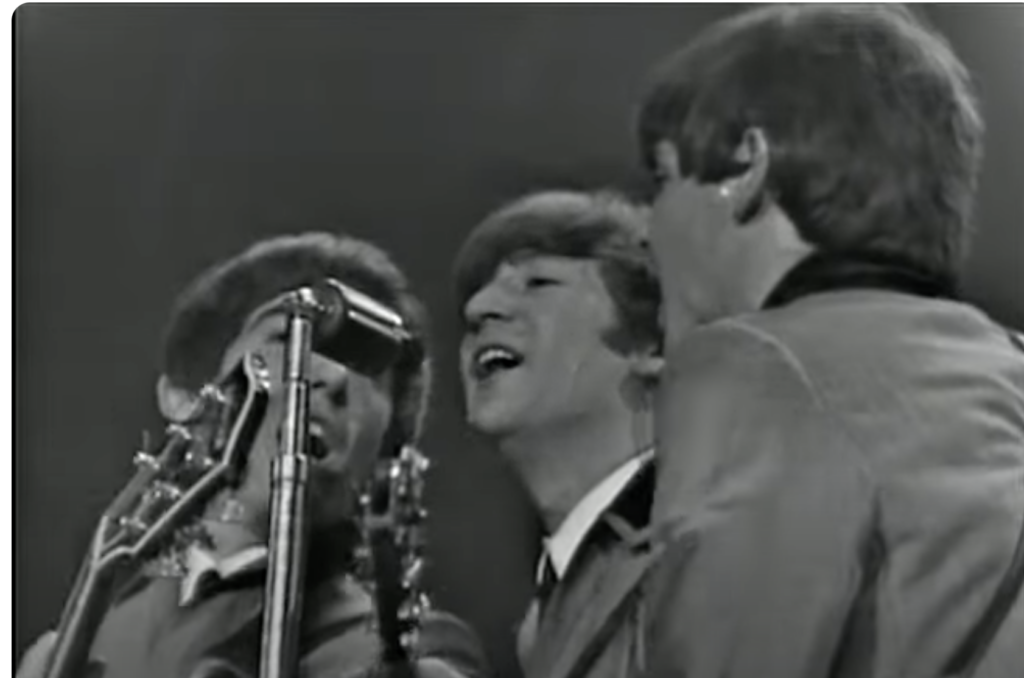
George Harrison, John Lennon and Paul McCartney, Washington, D.C., 1964 (YouTube screen shot)
In a time just after Kennedy and Camelot, America remained a version of the latter for the Beatles, with a spritzing of Utopia. This was a fantasy land that was somehow real, and where the Beatles themselves were now the sensation of the moment and one, it turned out, with staying power.
And so came the night of the big event—fitting language, given that this first American Beatles gig was to take place at the Washington Coliseum, a boxing arena, in front of 8,000 screaming, jellybean-tossing (on account of the Beatles expressing a fondness for the candy) fans. Jay and the Americans (having replaced the Chiffons, who couldn’t make it because of the snow), Tommy Roe and the Righteous Brothers opened, and then, at half past eight, it was time for the bill-toppers, and a dream come true.
Related: When the Beatles had the entire Top 5 to themselves
They opened, charmingly, with a cover of Chuck Berry’s “Roll Over Beethoven,” George Harrison singing lead. This strikes us as amusing now: First U.S. show, and Harrison kicks it off? We must remember that the Beatles weren’t sure how long they were going to last. Everything that was happening over the course of these days must have registered to them as surreal and likely temporary. How could any such thing be sustained? You want to make a good impression, though, and America was the land of the man we might call Mr. Maybellene, so why not serve the Americans something of their own?
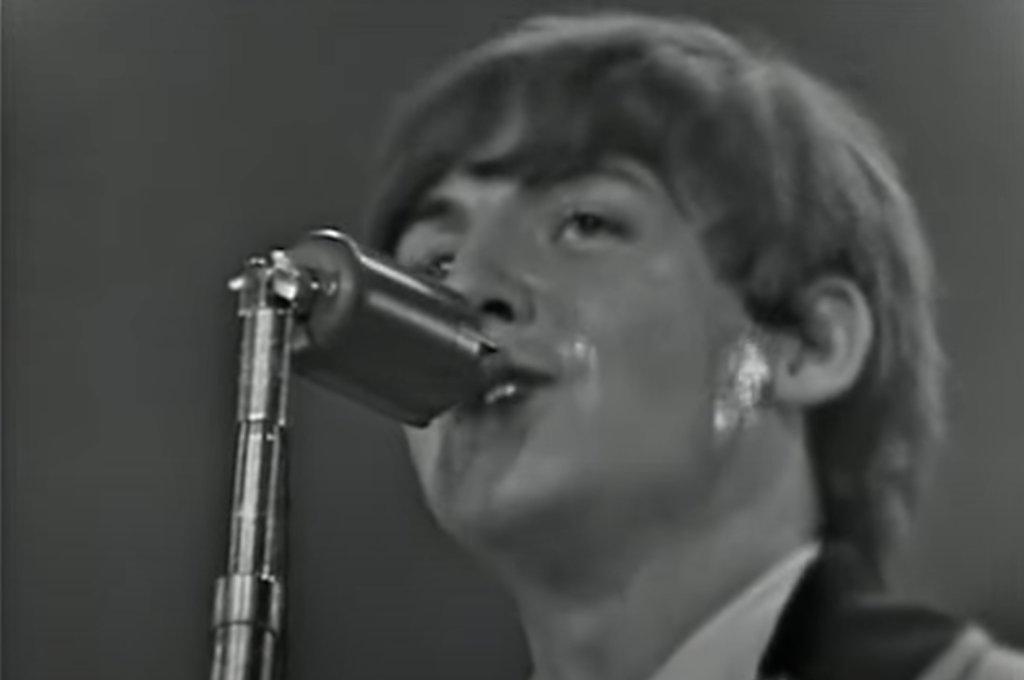
Paul gives it his all during “All My Loving” in D.C. (YouTube screen shot)
The number is tight, but it’s so jam-packed with energy that it feels like an achievement that they were able to keep it together. This wasn’t nerves, to the Beatles’ credit, but more like a super-force of cumulative adrenaline unleashed on guitars, bass, drums and in voices.
But you know what? “Roll Over Beethoven” registers as soporific after the fact when compared with the performance of “From Me to You” that follows. It is so apparent that both Lennon and McCartney cannot wait to have their turn to sing—on a shared lead vocal, as it were—that it’s as if they’re in a race to see who can sing the first note, ultimately hitting it at the same time.
The energy doesn’t let up throughout the band’s 12-song set, and at times it rises higher still, as with the groove they lock into during Harrison’s guitar solo—an all-out punk affair, with a side of Starr on display that we encounter nowhere else—on “I Saw Her Standing There,” or the thrilling climax of Lennon’s solo vocal turn on “This Boy” before the three-part harmony resumes. Lennon extends himself sufficiently far in said section that you’re left at a loss to explain how he had the breath to resume singing with his mates as quickly as he did, but the Beatles had shifted into their version of higher-power mode.

Ringo Starr, Washington, D.C., 1964 (YouTube screen shot)
Starr’s drums were on a riser, and every few songs roadie Mal Evans would come out and help rotate the awkward contraption (with enthusiastic assistance from the drummer himself—there’d be neither pride nor a fall this night) so that another section of the audience could have a straight-ahead view. Yes, this was America, but there was still something ramshackle about the affair that had to have felt like the Cavern back home, or the Indra Club in the pre-fame Hamburg days. Perhaps the Beatles, as they played, each had thoughts pass through their minds of seeing their rock and roll heroes at the Empire Theatre in Liverpool.
CBS filmed the concert and the music was available on a jagged-sounding bootleg—which, if anything, made that guitar solo in “Roll Over Beethoven” come off as more punk-ish—before a superior “board” tape was unearthed, and it is one of the jewels for the Beatles fan in the know.

Something to tell the grandkids: I was at the Beatles’ first American gig, in Washington. D.C.
If someone said to you before you heard that tape that the Beatles believed this was the last show they’d ever play and so they wanted to make it the best, most intense performance they could, you’d listen and have no problem accepting that this may have been true.
At the same time—or back then, at that time—one of the finest shows on American soil had just been played, and by the guys from somewhere else who’d only gotten here four days ago. You could say it was both a pretty redoubtable start and a dream made real.
Watch the full D.C. show
Related: Remembering another 1964 show, this time in Vancouver
McCartney has documented The Beatles’ 1963-64 days in a photo book, available here . The Beatles’ “red” and “blue” albums were upgraded in 2023. They’re available in the U.S. here and in the U.K. here .
- Latest Posts
- First Banger: The Shredding Delight of the Beatles’ ‘Can’t Buy Me Love’ - 03/24/2024
- The Beatles’ First American Show: The Gig They Dreamed Of - 02/10/2024
- The Beatles’ Decca Audition: An Invaluable Lesson in Failure - 01/01/2024
Stories We Want You to Read
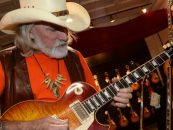
4 Comments so far
I wasn’t there for The Beatles first concert but I was for their last, August 29, 1966. I will never forget it. What a wonderful time to be young.
I was and still am a Beatles fan and have never seen that concert before! What a great piece of musical history for future fans to see. It will make them realize that 4 guys (3 guitars and a small drum kit) changed the world of music as we knew it. Live musicians who were excellent at their craft with amazing harmonies! I had to laugh tho…poor Ringo virtually had to set up his own kit and spin the table around on his own! And the other guys adjusted when the one mike wasn’t working! As young as they were, they were pros all the way! 60 years later and I still know all the lyrics!!! (I just turned 69). Long live the Beatles! Rock on, everyone. Peace to all!
excellent summary of the evening’s event
Love your post I’m 70 and agree completely!
Click here to cancel reply.
Your data will be safe! Your e-mail address will not be published. Also other data will not be shared with third person.
Comment * -->
This site uses Akismet to reduce spam. Learn how your comment data is processed .
Loading, Please Wait!
The Beatles First American Tour She's All Over the Place
Over more than half a century as a writer for the London Daily Express and the Times of London, British-born Ivor Davis covered major stories in North America. He penned a weekly entertainment column for the New York Times Syndicate for over 15 years, interviewing some of the biggest names in show business, from Cary Grant to Elizabeth Taylor, Richard Burton to Tom Cruise and Muhammad Ali. In 1962 he was smuggled onto the campus of the riot-torn University of Mississippi when James Meredith became the first black student to be enrolled --accompanied by 127 --yes 127-- US attorneys--Days of rioting followed with two killed--including one foreign journalist. Three years later Davis was in the front lines as Los Angeles’ Watts riots erupted. In l964, Davis was the only British daily newspaper correspondent to cover The Beatles’ first American tour from start to finish, given unparalleled access to John, Paul, George and Ringo on the road, in their hotel, and during long nights of card and Monopoly games as they talked frankly about their bizarre new life. He also ghosted a regular newspaper column for George Harrison. His first-hand, insider’s memoir, the award-winning The Beatles and Me On Tour, 60th Anniversary Book, was published in February. It is a fascinating journey back in time where for the first time he chronicles, frankly and humorously, 34 days with the world’s most famous band on the road—at a critical moment in the history of rock. The anniversary edition was published on Feb 9th this year. Davis covered Robert Kennedy’s 1968 presidential bid and was in the kitchen in the Ambassador Hotel the night Senator Kennedy was assassinated. He was one of the Boys on the Bus chronicling the life of actor-turned-politician Ronald Reagan, first in his campaign for governor of California, then for president. He was a co-author of the 1969 political book Divided They Stand, which chronicled the Presidential election; and witnessed some of the biggest trials in American history: Sirhan Sirhan, convicted of killing Bobby Kennedy in 1969; black-power militant Angela Davis, acquitted of murder in l972; a year later, Daniel Ellsberg’s trial for leaking the Pentagon Papers, and, in 1976, he was in San Francisco to see heiress Patty Hearst convicted of robbery after being kidnapped by the Symbionese Liberation Army. His new true crime book, “The Devil in My Friend: The Inside Story of a Malibu Murder.” It is an account of the famous Eighties trial of Malibu engineer Frederick George Roehler, who was convicted of the murder of his wife and young stepson after an almost year-long trial in the Santa Barbara Courthouse in May l982. The killings took place close by—at Santa Cruz Island. The new book will be published this year on May 7th. https://ivordavisbooks.com/ Connect more: https://www.chonacas.com/podcast/ https://www.instagram.com/shesallovertheplacepodcast/ https://www.linkedin.com/in/katiechonacas/ I hope you enjoyed the episode, please share with one person! Please leave a 5 star & review on Apple Podcasts as it supports me as an Independent Podcaster :) Thank you! Katie xo
- Episode Website
- More Episodes
- Copyright 2019 All rights reserved.
Top Podcasts In Arts
We will keep fighting for all libraries - stand with us!
Internet Archive Audio

- This Just In
- Grateful Dead
- Old Time Radio
- 78 RPMs and Cylinder Recordings
- Audio Books & Poetry
- Computers, Technology and Science
- Music, Arts & Culture
- News & Public Affairs
- Spirituality & Religion
- Radio News Archive

- Flickr Commons
- Occupy Wall Street Flickr
- NASA Images
- Solar System Collection
- Ames Research Center

- All Software
- Old School Emulation
- MS-DOS Games
- Historical Software
- Classic PC Games
- Software Library
- Kodi Archive and Support File
- Vintage Software
- CD-ROM Software
- CD-ROM Software Library
- Software Sites
- Tucows Software Library
- Shareware CD-ROMs
- Software Capsules Compilation
- CD-ROM Images
- ZX Spectrum
- DOOM Level CD

- Smithsonian Libraries
- FEDLINK (US)
- Lincoln Collection
- American Libraries
- Canadian Libraries
- Universal Library
- Project Gutenberg
- Children's Library
- Biodiversity Heritage Library
- Books by Language
- Additional Collections

- Prelinger Archives
- Democracy Now!
- Occupy Wall Street
- TV NSA Clip Library
- Animation & Cartoons
- Arts & Music
- Computers & Technology
- Cultural & Academic Films
- Ephemeral Films
- Sports Videos
- Videogame Videos
- Youth Media
Search the history of over 866 billion web pages on the Internet.

Mobile Apps
- Wayback Machine (iOS)
- Wayback Machine (Android)
Browser Extensions
Archive-it subscription.
- Explore the Collections
- Build Collections
Save Page Now
Capture a web page as it appears now for use as a trusted citation in the future.
Please enter a valid web address
- Donate Donate icon An illustration of a heart shape
The Beatles: The First US Visit
Video item preview, share or embed this item, flag this item for.
- Graphic Violence
- Explicit Sexual Content
- Hate Speech
- Misinformation/Disinformation
- Marketing/Phishing/Advertising
- Misleading/Inaccurate/Missing Metadata
plus-circle Add Review comment Reviews
4,393 Views
33 Favorites
DOWNLOAD OPTIONS
In collections.
Uploaded by Fruithunter Films on May 6, 2022
SIMILAR ITEMS (based on metadata)
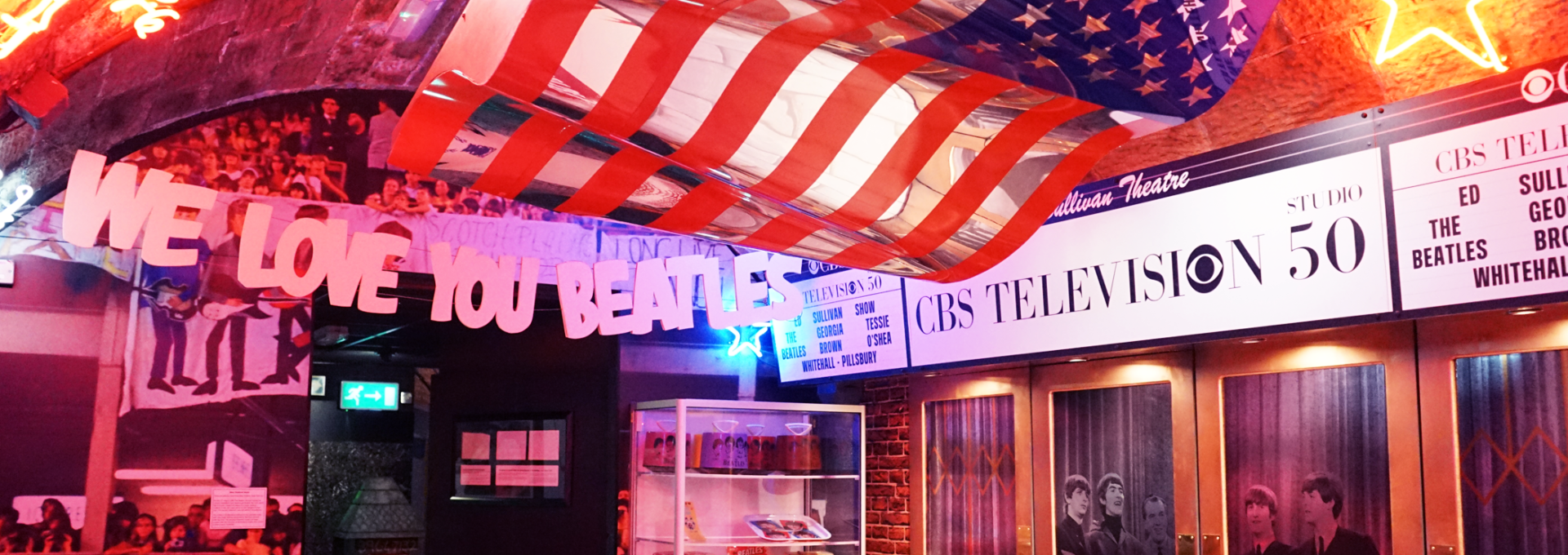
The Beatles in the USA Exhibition
'The Beatles in the USA' exhibition at The Beatles Story Museum, Liverpool, with elaborate sets that transport you back in time, as the British Invasion began to captivate American teens, and Beatlemania was born.
The Beatles in the USA
‘The Beatles in the USA’ exhibit at The Beatles Story Museum, Liverpool, with elaborate sets that transport you back in time, and fascinating pieces of original memorabilia from days gone by, perfectly captures the beginning of a new era in American culture as the British Invasion began to captivate American teens, and Beatlemania was born.
Exiting our recreation of the Pan Am Boeing 707 flight that The Beatles flew to New York in, you’re greeted by a recreation of the CBS Television studio used to film their Ed Sullivan Show appearance.
Ponder on a wealth of key information, and admire our collection of original memorabilia taking you back in time to when the Fab Four lads from Liverpool arrived in the USA.
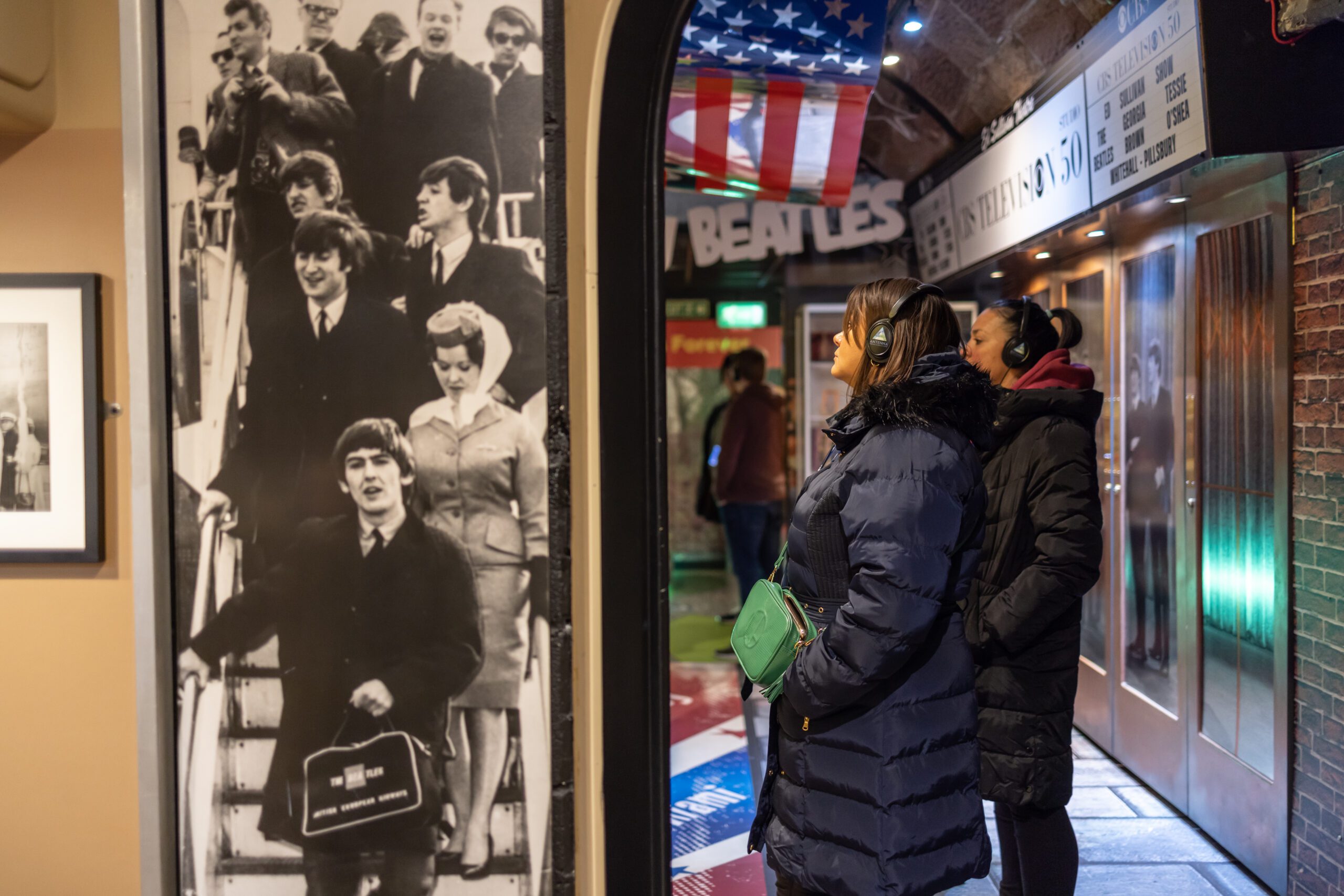
The Beatles in USA Memorabilia
Discover a wealth of authentic memorabilia on display within the USA section at The Beatles Story Museum.

- Share full article
Advertisement
Supported by
See the Beatles’ First Tour Through Paul McCartney’s Lens
Sixty years after the Beatles appeared live on “Ed Sullivan,” McCartney reflects on his photos capturing those halcyon days. The Brooklyn Museum will exhibit them, and some will be for sale later.

By Lucie Young
They are now a collector’s trove — Paul McCartney’s own photos, shot 60 years ago, when the Beatles took Europe and America by storm: images of screaming fans (one carrying a live monkey); a girl in a yellow bikini; airport workers playing air guitar, and unguarded moments grabbed from trains, planes and automobiles.
McCartney, now 81, doesn’t like to sit still and reminisce about the past, so he chatted while driving home from his recording studio in Sussex, England. “My American friends call these small, one-way lanes ‘gun barrels,’” he said, warning his interviewer that at any moment the signal might die (it did). In the end, it took two days to complete a coherent conversation about the breakthrough period when the Beatles went viral, captured in the traveling exhibition “Paul McCartney Photographs 1963-1964: Eyes of the Storm,” which features 250 of his shots. Currently it’s at the Chrysler Museum of Art in Norfolk, Va. , and comes to the Brooklyn Museum May 3-August 18. (Don’t be surprised if the artist shows up for the opening.)
It was McCartney’s archivist, Sarah Brown, who found 1,000 photographs the musician had taken over 12 weeks — from Dec. 7, 1963, to Feb. 21, 1964 — in the artist’s library.
“I thought the photos were lost,” he said. ‘‘In the ’60s it was pretty easy. Often doors were left open. We’d invite fans in.” Even the recording studio wasn’t a safe space. “I was taking my daughter Mary to the British Library to show her where to research for her exams, and in one display case I saw the lyric sheet for ‘Yesterday,’” he said. A sticky-fingered biographer had swiped the original from their studio.
Rosie Broadley, a senior curator at the National Portrait Gallery in London, where the show was inaugurated, said, “His photographs show us what it was like to look through his eyes while the Beatles conquered the world.”
McCartney won an art prize at school and practiced photography with his brother, Mike (who later became a professional photographer). He graduated to a 35 mm SLR Pentax camera when the Beatles hit it big.
“It was the most sophisticated hand-held camera of the era. It would be like having the latest iPhone today,” Darius Himes, Christie’s international head of photography, said, adding: “We were all quite surprised by Paul’s sophisticated eye, and his awareness of trends in the visual arts. The yellow bikini shot is like a striking mix of Stephen Shore, William Eggleston and William Klein.”
The Beatles traveled with a flock of cameramen and were not shy about gleaning tips. McCartney admitted some of his earliest shots in the exhibition are a little fuzzily focused. “I console myself that one of my favorite photographers, Julia Margaret Cameron , also liked soft focus,” he said.
“His photos get better as he practices,” Broadley noted. The exhibition, and its accompanying book, take visitors on a whirlwind trip through six cities beginning in Liverpool and London, and ending in Miami. The images from the British leg are exhibited in small ‘‘austerity’’ walnut frames, to indicate Britain was still in throes of a postwar recession. The Fab Four might look nervous in these photos, but they had already reached stardom on their home turf, having bagged three No. 1 singles.
After a brief stint performing at the Olympia in Paris, alongside Sylvie Vartan, they heard that “I Want to Hold Your Hand” was No. 1 on the American charts and sped to New York. The crowning moment in America was their live television debut on the “The Ed Sullivan Show” on Feb. 9, 1964, singing five propulsive pop hits — an event watched by 73 million people.
In Miami, McCartney’s photos burst into Kodachrome color and the newly minted celebrities seem to bloom in glamorous new surroundings: lounging poolside, sipping scotch and riding around in motorboats. By April, the Beatles’ songs held the top five spots on the U.S. Billboard charts.
Musing on the images, he said, “There is an innocence to them,” adding, “I think it was a lot more fun than it was. We worked probably 360 days out of the year.” It was an all too brief halcyon period. Two and a half years later, the Beatles stopped touring. The logistics, the screams, the armored cars, had become a nightmare.
Like most successful artists thriving past retirement age, McCartney has projectitis. He’s working on a new album with the producer Andrew Watt (“Hackney Diamonds”), and just released the 50th anniversary remaster of the Paul McCartney & Wings classic “Band on the Run.” “His live shows continue to be of such high voltage one half expects him to burst into flames,” the Irish poet Paul Muldoon wrote in McCartney’s recent book, “The Lyrics: 1956 to the Present.”
His next project is organizing a gallery sale of some of his photographs. “It’s a process I like,” he said, describing the joy of curating. “I’ve done it a few times with Linda’s work” [a reference to his first wife, the photographer, Linda Eastman]. His current homes, shared with his wife Nancy Shevell , are adorned with images by Linda and Mary, though, curiously, none of his own. But that may change. ‘‘The sale,” he said, “will probably encourage me to get some for myself.”
Here are edited excerpts from our conversation, in which he reflected on popular images in the exhibition.
John Lennon. London, January, 1964
My favorite photos are of John and George. There’s a huge sentimental aspect to them. No one else could have taken this pic. John was a great character. A very different kind of guy to the other boys I knew. We met at the village fete. He was playing with his band. He was a year and a half older than me [and] my first friend who wore glasses. He was always taking them off and polishing them. I found it fascinating. He’d take them off in public, which rendered him half blind. Onstage, he just stood there and gazed out into the blackness. Maybe it helped him focus on playing.
John, George and Ringo backstage in their dressing room. London, 1963.
We began by playing in really crummy little clubs and bars in Liverpool and Hamburg. In Germany, we slept in a little room, with a Union Jack flag for a blanket. Back in England, it started to get a little better. We played in ballrooms, got radio work and then TV work. It was like a staircase ascent for us. What nobody realized is, by this time [seven months after the Beatles’ first No. 1 hit on the U.K. charts], we were really fully formed beasts. We’d come from the postwar years into a Britain that was now experiencing joy for the first time in decades, and we ate it up.
Self-portraits. Paris, 1964.
Our Pentax cameras were probably a gift. There was a lot of artistic black and white photography emerging at that time. We admired David Bailey [who had a Pentax camera], Don McCullin , a stunning war photographer, and Norman Parkinson . When he took our picture, he’d say ‘give me big eyes’ and we’d all play along. I like to shoot through the mirror because things look good in a mirror. We all smoked. Smoking gave us a suave, grown-up feel. We were pretty young. I was just 21.
Ringo Starr. Paris, 1964.
Our aim was always to have fun. I think that communicates itself and became part of the reason we were so popular. It is just a characteristic of Liverpool people to have a laugh. [Paul snapped this shot of Ringo during a staged photo shoot with Dezo Hoffmann, one of their court photographers.] Dezo was a very nice guy. He would give us hints as to the aperture and all the various things needed to make a good photograph.
Fans welcoming the Beatles at Central Park. New York, February 1964.
Here’s a pic of Beatles fans acting like they should. … Going crazy! We didn’t know what we were gonna get in America; if anyone would turn out to meet us. On the plane over, the pilot radioed ahead and was told there were gangs of fans waiting. [Over 4,000 screaming girls held back by 200 policemen.] Manhattan was big, tall, loud and brash. There were stories of fans breaking into our room at the Plaza Hotel. Those were more stories than reality. We probably wished it would happen.
Ringo Starr setting up his drum kit during rehearsals for “The Ed Sullivan Show.” New York, February 1964.
We had done television in England, so we were used to it; the cameras and the lights and all that. What we didn’t really know was how important Ed Sullivan was. He was the BIG ONE. There were two stagehands waiting to draw back the curtains for us to go on and one said: ‘You nervous?’ I said, ‘I dunno. Not really.’ He says: ‘You should be. There’s 73 million people watching.’ Then I got nervous. But if you watch that performance, I can’t believe how confident we look. The weird thing about the stage set is Ringo’s [precarious] drum rostrum. I can’t work out how he got up there.
Photographers in Central Park. New York, February 1964.
New York journalists thought they were pretty smart and I’m sure they were used to handling dumb pop stars. We had a lot of fun with them, especially at the news conference at J.F.K. [Airport]. We gave as good as we got. It became a game of who could come up with the smartest answer. Often it was the truth. Someone asked George, ‘Do you ever get your hair cut?’ He said, ‘Yeah, yesterday.’ And he’d been to the barber’s the day before.
Unknown man. Taken from the window of train from New York to Washington, D.C., February 1964.
We loved music and performing. It beat working in a factory. A few years before these pictures, we’d all been fully immersed in working class life in Liverpool. I have a fascination with working class people like this man [a railroad worker caught from a train en route to Washington, D.C.]. Working class people are the smartest people I’ve ever met. My cousin Bert [Danher] was an insurance salesman, but he also compiled crosswords for The Guardian and The Times. The photography I admire is spontaneous, like the work of the great [Henri] Cartier-Bresson. It was good to just grab shots on the run. We didn’t have time to think.
Unknown girl. Washington, February 1964.
Some of my favorite photos are of fans. I really like this one of a young girl with a headscarf looking in a Zen-like manner into my camera. I took it and never looked at it again until I did a print [for the National Portrait Gallery exhibition]. When we started blowing up the images, we got to see all the individual characters. In one photo, at Miami airport, there’s a woman holding up a monkey. You wouldn’t get that past health and safety these days.
George Harrison. Miami Beach, February 1964.
This is George living the life in Miami. [McCartney switched to Kodachrome to record the group’s antics in Florida.] Miami felt like wonderland. These pictures were taken at a time when we were all young and beautiful. I mean these are good looking boys, you know! From this perspective, I feel very blessed to have not only known these guys, but to have worked with them and done such great things with them. I feel very blessed.
An earlier version of this article misidentified the member of the British royal family who met with the Beatles in 1963. The Beatles met the Queen Mother (and Princess Margaret) that year; they met Queen Elizabeth II in 1965.
How we handle corrections
Find the Right Soundtrack for You
Trying to expand your musical horizons take a listen to something new..
St. Vincent dives headfirst into the darkness.
Taylor Swift sells a rainbow of vinyl albums. Fans keep buying them.
Sabrina Carpenter drops a perky bop, and 10 more new songs. Hear the Playlist .
How the trumpeter Jeremy Pelt chronicles Black jazz history.
Lost tapes from major musicians are out there. These guys find them .
PODCAST | NOTABLE RELEASES | NEWS | REVIEWS | FEATURES
Umg celebrating the beatles 60th anniversary of first us tour.
Posted by Buddy Iahn | Jun 14, 2023
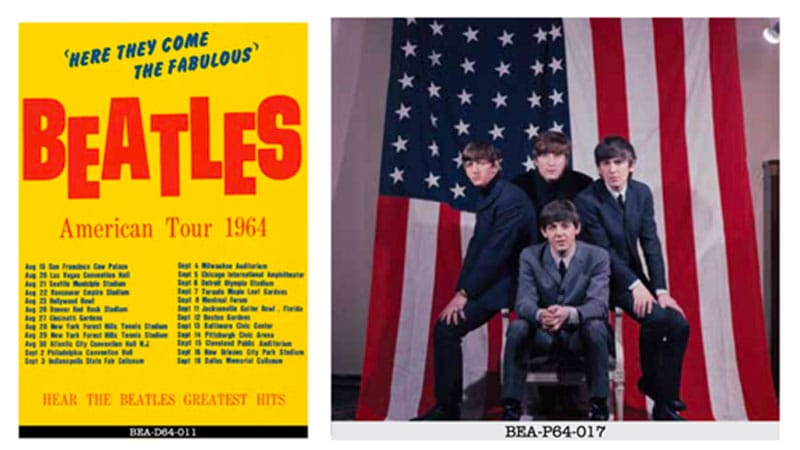
Bravado marks iconic moment in American culture
Universal Music Group’s (UMG’s) leading merchandise and brand management company, Bravado, recently continued their partnership with The Beatles alongside Apple Corps, laying the groundworks for an amazing year ahead celebrating the band’s iconic moments in American culture.
With over 60 new and current licensees across Beatles and Yellow Submarine , there will be new collections and collaborations to celebrate this historic anniversary throughout. Licensees include Kith, Hybrid, Mattel, Market, Chaser, Goodie Two Sleeves, Casely, Loungefly, Happy Socks, Christopher Radko (Rauch Brands), Section 119, State Bicycles, USAOpoly, AKILA Eyewear, MEGA Blox, Insights Editions, Hot Wheels and more.
This coming 2024, will mark the 60th anniversary of The Beatles First US Tour which included stops in San Francisco, Las Vegas, Vancouver, Los Angeles, Denver, Cincinnati, New York, Atlantic City, Philadelphia, Milwaukee, Indianapolis, Chicago, Detroit, Jacksonville, Boston, Baltimore, Pittsburgh, Cleveland, New Orleans, Kansas City and Dallas.
Kicking off the tour February 9, 1964, nearly 60 years ago, Ed Sullivan took stage and said, “Ladies and gentleman, The Beatles!” to a then record setting audience of 73 million Americans, which at that time was 40 percent of the US population, and to this day ranks among the Top Thirty Most Viewed American Television shows.
This cultural phenomenon was a moment in time that launched the biggest band in history alongside some of their biggest hits from the tour’s setlist, including “Twist and Shout,” “If I Fell,” “A Hard Day’s Night” and others.
Paying homage to the milestone 60th anniversary, the program will celebrate all the cities and fabled venues they played on their first American tour as well as their uniquely American album artwork from that time.
About The Author

Buddy Iahn founded The Music Universe when he decided to juxtapose his love of web design and music. As a lifelong drummer, he decided to take a hiatus from playing music to report it. The website began as a fun project in 2013 to one of the top independent news sites. Email: [email protected]
Related Posts
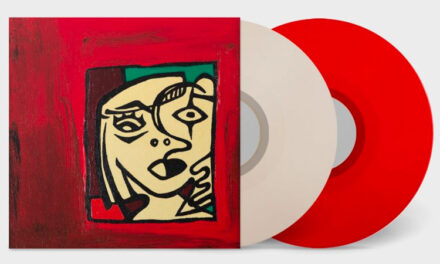
Sixpence None The Richer ‘This Beautiful Mess’ gets vinyl reissue
August 17, 2021
Hendrix, Dylan, Alice in Chains among RSD Black Friday exclusives
October 25, 2016
Collective Soul announces 11th studio album
July 8, 2022
Air Supply, Camila Cabello, Sebastian Bach join Festival d’été de Québec
May 1, 2018
Recent Posts
- Logic releases ’44ever’ April 19, 2024
- Lou Reed, Velvet Underground profiled in new book April 19, 2024
- MacKenzie Porter serves up ‘Have Your Beer’ April 19, 2024
- Shane Profitt shares ‘Whiskey With You’ April 19, 2024
- Jason Derulo, Rehab team for ‘Animal’ April 19, 2024
- Locash shares ‘Hometown Home’ April 19, 2024
- $uicideboy$ releases new song April 19, 2024
- Joe Bonamassa releases ‘Ball Peen Hammer’ from Hollywood Bowl concert April 19, 2024
- Clay Walker raises more than $2 million for Multiple Sclerosis research April 19, 2024
- From Ashes to New announces ‘Blackout’ digital deluxe edition April 19, 2024
- Search Please fill out this field.
- Manage Your Subscription
- Give a Gift Subscription
- Newsletters
- Sweepstakes
- Entertainment
The Beatles: All About the Members of the Legendary Band
The Beatles is one of the biggest rock groups in history thanks to hits like “Here Comes the Sun” and “Yesterday”
Nicole Briese is a contributing writer at PEOPLE. She has been working at PEOPLE since 2022. Her work has previously appeared in Us Weekly, Brides and MTV News.
:max_bytes(150000):strip_icc():format(webp)/nicole-briese-author-bio-c706a957a0fb4d6187ee6a6c1c83e834.jpg)
Arguably no group in rock history has had a bigger impact than The Beatles .
Paul McCartney , John Lennon , George Harrison and Ringo Starr , a.k.a. The Fab Four, produced 19 No. 1 albums, scored 20 No. 1 singles on the Billboard Hot 100 and became the best-selling music artists of all time, per the Recording Industry Association of America .
Founding members McCartney and Lennon met in Liverpool , England, on July 6, 1957. That day, McCartney played with Lennon’s band, The Quarrymen, and they bonded over their love of songwriting.
"I turned round to him right then on first meeting and said, 'Do you want to join the group?' ” Lennon said of his bandmate in The Beatles Anthology . “And he said ‘yes’ the next day as I recall it.”
McCartney brought his school friend, Harrison, into the fold in 1958, according to Far Out Magazine . After The Quarrymen rebranded as The Beatles in 1960, the group went through several more early lineup changes — including the addition of Starr and brief tenures of bass player Stuart Sutcliffe and drummer Pete Best. The Beatles released their debut album, Please Please Me , in 1963.
Proof of the band’s international success came on Feb. 9, 1964, when a record-breaking 73 million viewers tuned in to watch them perform on The Ed Sullivan Show . They went on to release 12 more albums and spawned hit after hit, including “Here Comes the Sun,” “Come Together,” “Let It Be,” “Hey Jude” and “Yesterday.”
The group won seven Grammys and was honored with titles as Members of the Order of the British Empire in 1965. In 2014, The Beatles were recognized with a lifetime achievement award from the Recording Academy.
Jeff Hochberg/Getty
For all its highs, the band also experienced incredible lows. Manager Brian Epstein died of an accidental drug overdose in 1967 and tensions subsequently boiled over the group’s direction. Starr temporarily left the band in August 1968 and Harrison famously stormed out during Get Back recording sessions . The Fab Four reunited for their famous London rooftop concert on Jan. 30, 1969, before calling it quits for good in 1970.
While McCartney was largely blamed for the group’s demise, he later denied initiating the breakup .
“I am not the person who instigated the split,” he told This Cultural Life in 2021. “John walked into a room one day and said ‘I am leaving the Beatles.’ ” In 2020, Howard Stern asked McCartney why they didn’t continue without Lennon. “We’d been through too much and we were just fed up,” he recalled.
Lennon and McCartney became estranged when McCartney filed a lawsuit to dissolve The Beatles’ business affairs and sued his bandmates over legal rights to their work in 1970.
"If I hadn't done that, it would have all belonged to Allan Klein ," McCartney later told British GQ of their manager, who replaced Epstein in 1969.
All four Beatles released solo albums in 1970 and Lennon and McCartney made peace nearly 10 years later — shortly before Lennon was killed outside his apartment by Mark David Chapman on Dec. 8, 1980.
Starr and Harrison reunited with Yoko Ono and Lennon’s sons, Julian and Sean , in 1988 when The Beatles were inducted into the Rock and Roll Hall of Fame. All three living members also collaborated on The Beatles Anthology , which consisted of a TV documentary, a three-volume set of double albums and a book. In 2001, Harrison died of cancer.
Here is everything to know about the members of The Beatles and their legacies.
John Lennon
Mark and Colleen Hayward/Redferns ; New York Times Co./Larry C. Morris/Getty
John Lennon was born on Oct. 9, 1940, to Julia and Alfred Lennon, a seaman who left home when the musician was very young. He was raised in Liverpool by his aunt Mimi.
When he was 16, Lennon formed The Quarrymen, which would eventually morph into The Beatles. While he wrote many of the band’s hits with McCartney, Lennon also wrote several songs on his own, including “Help!,” “It Won’t Be Long,” “Strawberry Fields Forever” and “Across the Universe.”
Lennon married fellow Liverpool College of Art student Cynthia Powell on Aug. 23, 1962, and on April 8, 1963, the couple welcomed a son, Julian.
Lennon left Powell for Ono in 1968. In a 2022 appearance on Elton John ’s radio show Rocket Hour , Julian shared that the divorce spurred McCartney to write “Hey Jude,” originally titled “Hey Jules,” to comfort him.
Mondadori/Getty
On March 20, 1969, Lennon married Ono . They hit a rough patch in 1973, and Lennon had a relationship with the couple’s assistant, May Pang , but he reconciled with Ono in early 1975. They welcomed a son, Sean , on Oct. 9 of that year.
Between 1968 and 1980, Lennon released 10 albums, including five with Ono. He even recorded “How Do You Sleep?" a song with angry lyrics aimed at McCartney, in 1971, but the men later made peace .
"I was very glad of how we got along in those last few years,” McCartney wrote in his book The Lyrics: 1956 to the Present .
Lennon was murdered by an obsessed fan outside of his Manhattan apartment on Dec. 8, 1980. The tragedy deeply affected McCartney. “I couldn't really talk about it,” he told SiriusXM’s The Beatles Channel in 2022. “I couldn’t put it into words.”
The Recording Academy posthumously recognized the songwriter with a lifetime achievement award in 1991; three years later, McCartney inducted him into the Rock and Roll Hall of Fame as a solo artist.
Paul McCartney, 81
David Redfern/Redferns ; Kevin Winter/Getty
Sir James Paul McCartney was born in Liverpool on June 18, 1942. His father, James McCartney, was also musically inclined, according to Encyclopedia Britannica , and played in a band called Jim Mac’s Jazz Band.
McCartney was introduced to Lennon through a mutual friend. "I'd never met anyone who said he'd written a song,” McCartney wrote in his book Lyrics . “The logical extension was, ‘Well, maybe we could write one together.' ”
Though McCartney initially played guitar, he switched to the bass after Sutcliffe departed the band in 1961. He also split main vocal duties with Lennon and played the piano, drums and guitar. McCartney and Lennon became known for their songwriting partnership, but McCartney took the lead for at least 70 Beatles songs, including “All My Loving,” “Yesterday,” “Blackbird” and “Let It Be."
Following the band’s split, McCartney found himself at a crossroads . “It was a hard act — some might say, an impossible act — to follow,” he wrote on his website in 2023. Soon after the band's split, though, he recorded two chart-topping solo albums: McCartney and Ram . He also formed the group Wings with his first wife, Linda McCartney (née Eastman), whom he married in 1969.
Wings was a commercial success; its 1973 single “Band on the Run” hit No. 1 on the Billboard Hot 100 but the band split up in 1981. The Beatles, meanwhile, became embroiled in legal drama in 1970 when McCartney sued his three bandmates in order to end his contract with Apple Records. After manager Klein left the record company, The Beatles negotiated between themselves, and the group legally dissolved on Dec. 29, 1974.
Universal Archive/Universal Images Group/Getty
McCartney continued to record and tour solo, and in 1994, he rejoined forces with Harrison and Starr for the group’s Anthology project.
His wife Linda died of breast cancer in 1998. “I think I cried for about a year,” McCartney told the BBC in 2019. The couple shared four children : Heather, Mary, Stella and James. McCartney also shares daughter Beatrice with his second wife, Heather Mills, to whom he was married from 2002 to 2008. In 2011, he married Nancy Shevell.
McCartney is a two-time Rock and Roll Hall of Fame inductee and the recipient of 18 Grammy Awards. He was honored with a lifetime achievement award as a solo musician in 1990 and as a member of The Beatles in 2014. That same year, he and Starr hit the Grammys stage together in a rare performance of the surviving Beatles.
The performer collaborated with Rihanna and Kanye West on the chart-topping hit “FourFiveSeconds” in 2015. Three years later, he earned his first No. 1 album on the Billboard 200 chart in more than 36 years with Egypt Station . He released his 18th solo album, McCartney III , in 2020.
He hit the road for the “Got Back” tour starting in April 2022. A year after the tour started, McCartney appeared on The Rolling Stones' album Hackney Diamonds.
George Harrison
Fox Photos/Getty ; Tom Wargacki/WireImage
George Harrison, born on Feb. 25, 1943, was introduced to music by his father, Harold Hargreaves Harrison. “He used to go away to sea, and he brought back this big windup gramophone and Jimmie Rodgers records,” the musician told Billboard in 1992.
Harrison bought his first guitar at age 13. "It was such a bad guitar, all the frets buzzed, and you couldn't get certain notes out of it,” he told the publication.
Soon after, the rocker met McCartney at school in Liverpool, and McCartney introduced him to The Quarrymen in 1958. His bandmates wrote the majority of the material for the group, but Harrison penned a number of its biggest hits, including ”Here Comes the Sun.” Harrison also wrote, “While My Guitar Gently Weeps” and “Something."
On March 6, 1964, he met model Pattie Boyd on the set of A Hard Day’s Night . The couple married less than two years later.
In January 1969, Harrison left The Beatles out of frustration with McCartney and Lennon. “We'd do 14 of their tunes. And then they'd condescend to listen to one of mine,” he explained in a 1989 interview.
Though The Beatles worked things out soon after, the band fell apart within the year after Lennon quit.
After The Beatles’ demise, Harrison released his third solo album, All Things Must Pass , in November 1970. Its hit single, “My Sweet Lord,” made him the first Beatle to have a No. 1 single as a solo artist. He later re-recorded the track in 2000, just months before his death, with his son Dhani on acoustic guitar.
Universal Archive/Universal Images Group/Getty
Harrison earned his first solo Grammy in 1973 for the live album Concert for Bangladesh , which he organized with Ravi Shankar.
Boyd left Harrison for Eric Clapton in 1974 but remained close to the guitarist throughout his life. That same year, he met his second wife, Olivia Harrison , whom he married in 1978. They had one child, Dhani .
Harrison’s 1987 cover of James Ray’s “Got My Mind Set on You” hit No. 1 on the Billboard Hot 100 , and in 1988, he co-founded the Traveling Wilburys with Bob Dylan , Jeff Lynne, Roy Orbison and Tom Petty . The group released two albums.
In 1994, Harrison teamed up with McCartney and Starr to create The Beatles Anthology . McCartney saw Harrison for the last time in November 2001. “I sat with him for a few hours when he was in treatment about 10 days from his death,” McCartney told Uncut in 2008. “We held hands.”
On Nov. 29, 2001, Harrison died of lung cancer at the age of 58. He was posthumously recognized for his solo career by the Rock and Roll Hall of Fame in 2004, and he won a Grammy lifetime achievement award as a member of The Beatles in 2014 and as a solo artist in 2015.
His 2002 memorial, Concert for George , which featured performances by McCartney, Starr, Clapton and members of the Traveling Wilburys, was re-released in theaters for its 20th anniversary on Nov. 29, 2022.
Richard “Ringo Starr” Starkey, 83
CBS/Getty ; Denise Truscello/WireImage
Born Richard Starkey on July 7, 1940, Ringo Starr knew early on that he wanted to be a musician. By the time he was 13 Starr had decided on drums, according to his website .
At 17, he joined the Eddie Clayton Skiffle Band, and two years later, he moved on to Rory Storm and the Hurricanes. Starr enjoyed moderate success with the group, telling Modern Drummer in 1981 that it “used to be top of the bill.”
But he was receptive when manager Epstein gave him a call in 1962 to replace drummer Best in The Beatles. “I’d rather starve with a better band, and I felt the Beatles were a better band,” Starr said.
In 1965, the drummer married Maureen Cox, with whom he had three children : Zak, Jason and Lee. The pair divorced in 1975.
Starr remained with The Beatles until August 1968, when he took a brief hiatus. “I left because ... I felt I wasn’t playing great, and I also felt that the other three were really happy and I was an outsider,” he said in Anthology . During that time, he wrote one of his Beatles songwriting credits, “Octopus’s Garden.”
After The Beatles split in 1970, Starr released his first solo album, Sentimental Journey. He became the first member of the group with seven consecutive top 10 singles, including “It Don’t Come Easy” and “Photograph.”
Starr faced a barrage of health issues in 1979 — he underwent intestinal surgery that reportedly nearly killed him. The incident was followed by a house fire in November 1979 and a near-fatal car crash in May 1980.
ullstein bild via Getty
Starr became involved in film with roles in Blindman (1971), Son of Dracula (1973) and Caveman (1981). It was on the set of Caveman where he met his second wife, Barbara Bach . They got married on April 27, 1981.
The couple dealt with addiction and entered rehab together in 1988. "I didn't tour in the '80s,” he once told PEOPLE. “I got involved in a lot of substances and they became more important than anything else.”
The next year, he formed a new project, Ringo Starr & His All-Starr Band, which continues to tour.
In 2019, Starr released his 20th studio album, What’s My Name . As of 2022, he and McCartney were one Tony Award away from an EGOT, with Starr having won an Oscar with The Beatles in 1971 for the score of Let It Be , an Emmy in 2022 for the documentary The Beatles: Get Back and nine Grammys.
In February 2023, McCartney reunited with Starr at a birthday party for McCartney's daughter Stella; Starr shared a video on X (formerly Twitter) of the former bandmates dancing together.
Pete Best, 82
Mark and Colleen Hayward/Redferns ; Bill Tompkins/Getty
Pete Best was born Randolph Peter Scanland in India on Nov. 24, 1941 — his family moved to England when he was 4.
He met The Beatles through his mother, Mona Best, who booked The Quarrymen to open the Casbah Coffee Club, a music venue she ran out of their home. The group circulated through a number of drummers prior to Starr, but Best stuck around longer than most and played with them for two years.
The musician made his Beatles debut in Hamburg, Germany. Executive George Martin wanted to sign the band to Parlophone Records, but he wasn’t a fan of Best’s drumming so he was replaced by Starr in 1962.
“When I got back home and I told my mother what happened, behind the sanctuary of the front door, I cried like a baby,” Best told The Irish Times in 2020.
He played in several bands after his dismissal, including Lee Curtis and the All-Stars; Best and some bandmates later broke off and became Pete Best & the All-Stars (later the Pete Best Four and the Pete Best Combo).
Hulton Archive/Getty
In 1963, Best married his wife Kathy, whom he met at a Beatles gig. They welcomed two daughters. Five years after he tied the knot, Best changed careers to focus on his family — according to the Australian Financial Review , he worked at a bakery and later at an employment exchange. Best later returned to music, forming the Pete Best Band with his brother Roag in 1988.
The Beatles 1995 album Anthology 1 included seven of Best’s tracks. “It showed the important role I played,” he told The Irish Times .
In 2002, Best and his brother published The Beatles: The True Beginnings , a book chronicling the Casbah Coffee Club and its kickstarting of The Beatles. In 2018, Best made his acting debut in the play Lennon’s Banjo , in which he acted as himself.
“I’m very proud of what I’ve achieved as a person, of the examples I’ve set to people to get on with your life, to pick yourself up,” he told The Irish Times in 2020. “I’m proud of that.”
Stuart Sutcliffe
Collect/Mirrorpix/Mirrorpix/Getty
Born in Edinburgh, Scotland, on June 23, 1940, Stuart Sutcliffe was accepted into the Liverpool College of Art when he was 16 years old. He first became friends with Lennon there, according to The New Yorker .
When Sutcliffe sold a painting at a prestigious art exhibition for £90 in 1959, Lennon talked him into putting the proceeds toward a Höfner 333 bass. Sutcliffe became passionate about music and he joined The Quarrymen in 1960.
Sutcliffe, who was also living with Lennon, joined the group for its overseas debut in Hamburg, where the group played more than 100 shows. There, he met and fell in love with artist Astrid Kirchherr so he stayed in the country when his bandmates returned to England. He returned to the United Kingdom in January 1961 but made plans to come back to Kirchherr.
K & K Ulf Kruger OHG/Redferns
Sutcliffe left The Beatles in July 1961 to focus on his art, and he moved to Hamburg to attend art school and be closer to Kirchherr. In Germany, he began to have a host of health problems, including what he reportedly called “a shadow” on his lungs, gastritis and an appendix that required surgery. The New Yorker reported that Sutcliffe also experienced convulsions that left him unable to attend classes.
The musician died of a brain hemorrhage on April 10, 1962, at age 21. “John went into hysterics,” Kirchherr recalled of breaking the news to Lennon. “We couldn’t make out ... whether he was laughing or crying.”
Sutcliffe’s image was included on the album cover of Sgt. Pepper’s Lonely Hearts Club Band as well as Lennon’s Rock ’n’ Roll in 1975.
The late performer is largely remembered for his art. According to his website , the Guggenheim Museum in New York City displayed two of his pieces from May 2019 to January 2020.
“Once in a while, we would start playing a Beatles song, and John would go, ‘Cut that out!’” Session guitar legend Earl Slick on fast times with John Lennon and David Bowie – and saying no to Whitesnake
The venerable session ace has lived a life less ordinary and has the discography to show for it. Earl Slick tells us what it was like to share the stage and studio with music legends
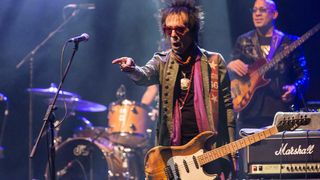
Throughout the ’70s and into the ’80s, Earl Slick was living most rock ’n’ roll guitarists’ dreams. He’d logged several worldwide tours with David Bowie and played a vital musical role on albums such as Young Americans and Station to Station .
As if working with one British rock legend weren’t enough, in 1980 Slick was chosen by John Lennon to play guitar on the former Beatle’s first album in five years, Double Fantasy .
“That’s just the tip of the iceberg,” Slick says. “I was really, really busy back then. There are days now when I astonish myself going, ‘Christ, did I really do all that?’ I’ll go on Wikipedia and be like, ‘Oh, there’s this and that.’ Or somebody will call and say, ‘I was just on Spotify and you’re on this record.’ I’ll say, ‘Now that you mention it, I am. I forgot about that one.’”
By the mid-’80s, however, the high-profile gigs weren’t coming like they used to. Slick attempted a career reboot with ex-Stray Cats members Slim Jim Phantom and Lee Rocker in Phantom, Rocker & Slick, but their union lasted for only two albums.
After kicking a debilitating drug and alcohol dependency, he joined the L.A..-based glam-metal band Dirty White Boy, who went belly-up after one album. A short stint with another L.A. outfit, Little Caesar, yielded similar results. Finally, in 1992, fed up with beating his head against the wall, Slick decided to chuck it all and headed to Lake Tahoe. For the next four years, he pursued a “normal job” selling timeshares.
“Only problem was, I sucked at it,” he says with a laugh. “I was no good at it at all. It was a strange time – I was adjusting to being sober, and I was filled with anxiety and discouragement from being jerked around by record companies. I just thought, ‘I need a drastic change.’ So I went somewhere I could be anonymous and get away from it all.”
In an unlikely turn, Slick was tempted to ditch retirement by a Tahoe neighbor, Whitesnake singer David Coverdale, who floated an offer for the guitarist to join the veteran hard rock band.
Get The Pick Newsletter
All the latest guitar news, interviews, lessons, reviews, deals and more, direct to your inbox!
“I gave it some serious thought, but I finally had to say no,” Slick says, “I realized I would have been faking my way through it, and it would have backfired on both of us.” More to the guitarist’s liking was a six-month writing collaboration with Coverdale that resulted in the singer’s third solo record, 2000’s Into the Light .
After recording the album, Slick still wasn’t convinced that he was ready to return to music full time. That all changed in 1999, when he received a vague and bewildering email indicating that somebody was looking for him. Some amateur sleuthing revealed that the somebody was none other than David Bowie. “I contacted David, and before you knew it I was back in,” Slick says.
Over the next 14 years, Slick played with Bowie on Heathen (2002), Reality (2003) and The Next Day (2013) and toured with the singer until 2004 (after suffering a mild heart attack on stage in Prague, Czech Republic, during the Reality Tour, Bowie was forced to cancel his remaining dates and never resumed full-time performing).
Meanwhile, the guitarist released solid solo albums (2002’s Slick Trax , 2003’s Zig Zag and 2021’s Fist Full of Devils ), toured with the New York Dolls and the Yardbirds, as well as a band called Slinky Vagabond (which included the Sex Pistols’ Glen Matlock and Blondie’s Clem Burke).
Recently, Slick was reunited with various Bowie alumni (among them pianist Mike Garson, guitarist Mark Plati, bassists Gail Ann Dorsey and Tim Lefebvre) on a new band project, KillerStar , spearheaded by singer Rob Fleming and drummer James Sedge. The group recorded an album’s worth of material remotely, and there are plans to perform live.
Thus far, only two tracks have been released – the faintly Bowie-esque Should’ve Known Better blends classic rock and art rock, while Falling Through bears traces of prime Pink Floyd – but Slick isn’t sure which is which.
“I don’t know titles, really,” he says. “I don’t even know half of the Bowie titles I’m on except the hits. But I had fun doing the KillerStar stuff. It seemed like a good opportunity, and it turned out well. Technology is amazing; I can do all this recording without leaving home.”
I’m going to jump around a bit, but I wanted to start by asking you about Mark Plati. You two worked on some of David Bowie’s early 2000s records, and he produced your album Zig Zag . How do you two bond guitar-wise?
“We get on great. He’s a terrific guitar partner, but then he does everything. He’s a motherfucker of a rhythm player. He doesn’t just get the parts down – he gets the feel. Whenever we played together as a guitar team, if he was playing rhythm, I didn’t have to think about anything. It was great.”
Mike Garson is also on the KillerStar album with you. What do you remember about playing with Mike on Young Americans ?
“My recollections are vague. Out of all the stuff I did with David, I have a memory block about Young Americans , which doesn’t make sense because we were far more fucked up when we did Station to Station . On that record, we went in and we stayed there until we finished everything. With Young Americans , we did maybe a week of sessions and then we were back on the road. It wasn’t one continuous job, per se.”
Tony was there and he kept things organized, but the creative ideas, when it came to me, that was David. It was the same way with Harry Maslin and Station to Station
Even with your vague memories of Young Americans , can you speak to the differences in working with producer Tony Visconti on that record versus Bowie’s later albums?
“I might as well just stick my foot in my mouth. One thing about artists like David Bowie – there’s a producer there, but when we worked on parts and stuff, all of that was David. Tony was there and he kept things organized, but the creative ideas, when it came to me, that was David. It was the same way with [producer] Harry Maslin and Station to Station ; it came down to David. Most of it was the two of us working my shit out. Like on The Next Day , my favorite track is Valentine’s Day .”
Beautiful song.
“David played that for me in the control room on an acoustic the day we were going to cut it. As soon as I heard it, I said to him, ‘The Kinks’, and he went, ‘Great.’ If you notice, the rhythm guitars on that song are very Waterloo Sunset .”
That song has a memorable riff and a striking solo.
“Yeah, well, after I said ‘Kinks,’ I started to noodle around on some rhythmic things, and David said, ‘We need an opening riff and some other riffs.’ He would play a couple of notes, and I’d get an idea and develop it. Then I’d wait to see the smile on his face, and I’d think, ‘OK, now we got it.’ It never really took a lot of time.”
You mentioned Station to Station ; that title track is so revolutionary, and your end solo is way out-there in terms of experimentation. Do you ever listen to it and go, “What the hell were we doing?”
“[Laughs] I mean, on the occasion when I hear something on the radio or I might play a few tracks, part of me is going, ‘Christ Almighty, we really did pull off some cool stuff together, and it was timely.’ In hindsight, it doesn’t sound that outside the box, but at the time we did it, I guess it was.”
Do you remember which guitars you used on it?
“On Station , I used a Strat on some of the rhythm parts; actually, on the first half, where it’s a little dirge-y. Then when it goes uptempo, I’m using my black Les Paul on the rhythm and also on that solo.”
What about on Stay ? That’s another gem on Station to Station .
“The rhythm is the Les Paul, and the solo is the Strat.“
Both of those songs are so freeform; they feel like one-take keepers.
“ Stay was pretty much a one taker. On Station , we sat down with a couple of guitars, and we wanted it to have a little bit more structure to it, a little bit more of a melodic thing, which Stay wasn’t – that was just going to be a bluesy kind of free-form solo. But on Station , we wanted something different, so we were just sitting there with a few guitars and coming up with different licks for each little bit.”
Back to Young Americans for a second, was that your first contact with John Lennon?
“It was, but I can’t remember it.”
Because you were high at the time?
“Well, yes, I was. This is so strange because John is my favorite Beatle.”
No memory at all of working with him on Fame ?
“No, I can’t remember… So fast-forward to 1980. I was uncharacteristically nervous before Double Fantasy started. I went in early on the first day. I thought if I could grab a cup of coffee and a smoke and just chill out… I got to the studio and nobody was there – except for John. I introduced myself, and his reaction was, ‘Why?’ Because to him, we already knew each other. And I said, ‘Well… I don’t remember.’
“The second I said it, I thought, ‘Oh, God, this could go really bad.’ You know – he called me to play on his record, and he is who he is, and I’m telling him that I can’t remember playing with him on a Number 1 record. But he thought it was hysterical. It became kind of a joke during the recordings.”
Do you recall which guitars you used on Double Fantasy ?
“I used my ’65 SG Junior a lot. I had a black early ’70s Les Paul Special. Those were the two main ones. There was a Strat on a few of those things, as well as my ’68 Gibson J-45.”
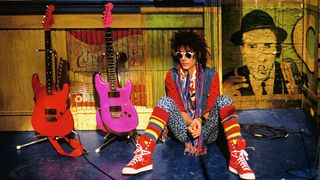
Did John have firm thoughts on guitar sounds or parts? Would he direct you at all?
“None of that came up at first. John didn’t lay out anything like, ‘OK, guys, maybe you should go for this sound or that sound.’ We would learn the songs – me, John and the other guitar player, Hugh McCracken – and as we went, John would say, ‘Slick, why don’t you go a little dirtier?’ Then he’d say to Huey, ‘Why don’t you try this?’ But that would happen as the tracks were being run down.”
Every day John would break into some ’50s or ’60s thing – Eddie Cochran or Buddy Holly. We’d all join in for a while, and then he’d say, ‘OK, back to work’
This was after a period when John sort of retired for five years. Was he a little rusty on the guitar, or did he have all his skills together?
“All of his guitar chops were there. His vocal chops were there. He was right on the money.”
As you and Hugh worked things out, did you do any jamming with John?
“Absolutely – and it was a gas. Every day John would break into some Fifties or Sixties thing – Eddie Cochran or Buddy Holly. We’d all join in for a while, and then he’d say, ‘OK, back to work.’ Once in a while, Hugh and I would start playing a Beatles song, and John would go, ‘Cut that shit out!’ It was really funny.”
Which Beatles songs would you play?
“There were a few things. One that would really get to him was She’s a Woman , which isn’t a Lennon song. It’s a McCartney song.”
In his last interviews, John said he planned to tour. Did he talk to you about being in the band?
“Oh yeah, it was all set. He started to talk about it during the last couple of weeks of recording, and in the final week he went to everybody individually and asked if we wanted to do it. The obvious answer was yes. [Laughs] At the time, I had just signed to Columbia, and I was supposed to start a record in February of ’81.
“At that point, John had a plan to do Double Fantasy and Milk and Honey at the same time, but then the plan changed to put out Double Fantasy first, and then we’d finish Milk and Honey and go out on tour.
“I explained my situation to John, that I had a record deal and all that. He got in touch with my management, and they worked everything out with Columbia, who were actually thrilled I’d be going out with Lennon before my record. Sadly, none of that happened.”
Soon after, you were working with Yoko again on Season of Glass with Phil Spector producing.
“Yeah, for the first two weeks. Thank God she got rid of him. It was a nightmare. I mean, he was crazy.”
I’ll do my best deadpan: No, really?
“Yeah. [Laughs] It was the same band from Double Fantasy , but [producer] Jack Douglas wasn’t there. When Yoko said Phil was doing the record, I thought, ‘I’ve worked with a lot of the best producers, and it will be great to work with Phil Spector.’ Well, my tune changed within the first 24 hours of being in a studio with him. He was a fucking nut.”
Phil Spector had a bodyguard the size of the Empire State Building with him, and he was carrying one of those long barrel Clint Eastwood .44 Magnums in a shoulder holster
Did he bring guns to the studio?
“Oh yeah. He had a bodyguard the size of the Empire State Building with him, and he was carrying one of those long barrel Clint Eastwood .44 Magnums in a shoulder holster. I’m going, ‘Dude, this woman’s husband was just killed, and you’re walking around with a gun.’
“The sessions were torturous. I got in the elevator one day with Yoko, and I said, ‘What time is Phil coming in?’ She goes, ‘He’s not going to be here today.’ I asked when he was coming back, and she said, ‘He’s not.’ That was the entire conversation.”
Moving forward, after a while apart, you were pulled back into Bowie’s orbit. Was there a pattern in how and when he called you for various albums and tours?
“I had to learn how David’s mind works. Whatever hit him at a particular time, that’s what he did. I had to go with the flow. I remember I played with him in 2000 – we did Glastonbury and a gig at the BBC Theatre. There were some gigs in New York.
“A while later, he was talking about touring on the Heathen record. So this is weird – I got a call from Mark Plati, and he said, ‘Before you hear this from somebody else, it looks like David’s got another guitar player, so you won’t be going on the tour.’ I just went, ‘Well, another day with David.’
“I was in New York for the week, so I emailed David and asked if he wanted to have coffee. We were supposed to meet, but then his assistant called and said he wasn’t feeling well, and then she asked me to lunch. I went to meet her, and then we went to Looking Glass Studios, where David was doing some vocals. He wasn’t well; he had a cold or the flu. I said hi and was there for a bit, and finally he said, ‘By the way, what are you doing in April?’ I just laughed and said, ‘Why, what’s going on?’ He said, ‘We’re going out.’ I said, ‘Great.’ That’s just the way it went.”
You’re on a couple of other songs on The Next Day – Dirty Boys and (You Will) Set the World on Fire . How did David arrive at which songs he wanted you to play on?
“On that album, unbeknownst to me, David had been in the studio on and off for a year. I was in touch with the guys playing on it, but nobody could say a word because they signed NDAs. So I’m in Montclair, New Jersey, doing a blues gig. I was with a surgeon friend and he had a Cobra car. He said, ‘Hey, let’s drive the Cobra to the gig.’ Sounded good to me… On the way there, the engine caught fire and the car blew up.”
“We’re in this high-end neighborhood, and there’s this car in the middle of the street engulfed in flames. The police and news people came down. Somebody spotted me, and it hit the internet. David saw this and he sent me an email – ‘Are you OK?’ I wrote him back and said I was fine. A couple hours later, I got another email – ‘So how have you been?’ ‘Good, how are you doing?’
“We started doing these weird emails throughout the day, and finally I said, 'Are you going somewhere with this?' He goes, 'I’m in the studio making a record, and you need to play on it.' When I got to the studio, I said to him, ‘Did I have to blow up a fucking car?’ [Laughs] You can’t make this shit up.”
Were you surprised when he didn’t call you for Blackstar ?
“No. The thing with Blackstar was, none of us knew he was ill. We knew he was ill when the announcement came that he was dead. I spoke to him on the phone the October before he died. I had to ask him some questions because I was doing that Station to Station tour in the U.K. and Japan with Bernard Fowler.
“We had a conversation, but he didn’t mention Blackstar . None of us from the band are on that record, and I can see why. It’s a different kettle of fish from what we would’ve done; it’s kind of an odd jazz thing going on. With David, people were always coming in and out.”
The thing with Blackstar was, none of us knew he was ill. We knew he was ill when the announcement came that he was dead
Another guitarist David worked with quite extensively was Reeves Gabrels. You two never played together with David, though, right?
“Not with David, but Reeves did work on my last solo record. We met around 2010 or so, and we discovered we had more than David in common. When I was just starting out, my bands would play in Staten Island, and Reeves would come to watch me. I had no idea about that until we met.”
You two have jammed together?
“Oh, yeah. A while ago, I was in England working with Glen Matlock, and Reeves was around. We had him come in and sit in with us. As weird as he can play, he can play anything. He’s fantastic.”
You turned down joining Whitesnake because you knew it wouldn’t be a good fit, but have you ever accepted a gig and regretted it?
“There has been that. There have been times when things were slow, and something would come up and I’d do it. But I try to suss that out beforehand so I don’t wind up in something that doesn’t work.”
What kinds of guitars are you playing these days? I assume it’s a lot of your signature guitars …
“Slick Guitars – we’ve got a new batch coming soon. We had one last year [the SL56] with f-holes. It’s really lightweight. The pickups kick ass. They’re made by GFS, but they’re Slick brand pickups. The Tele -style pickups are like old-school Tele models. I play Nash guitars a lot, and I’ve been playing Teles again.
“I’m back to Fender amps . For the last 10 years, I’ve been playing Teles. A few years ago I went out and used Supros. Then when I got home, I plugged into a Bassman and a Marshall Plexi, and I went, ‘A Telecaster with these amps – that’s the shit.’”
Thank you for reading 5 articles this month**
Join now for unlimited access
US pricing $3.99 per month or $39.00 per year
UK pricing £2.99 per month or £29.00 per year
Europe pricing €3.49 per month or €34.00 per year
*Read 5 free articles per month without a subscription
Prices from £2.99/$3.99/€3.49
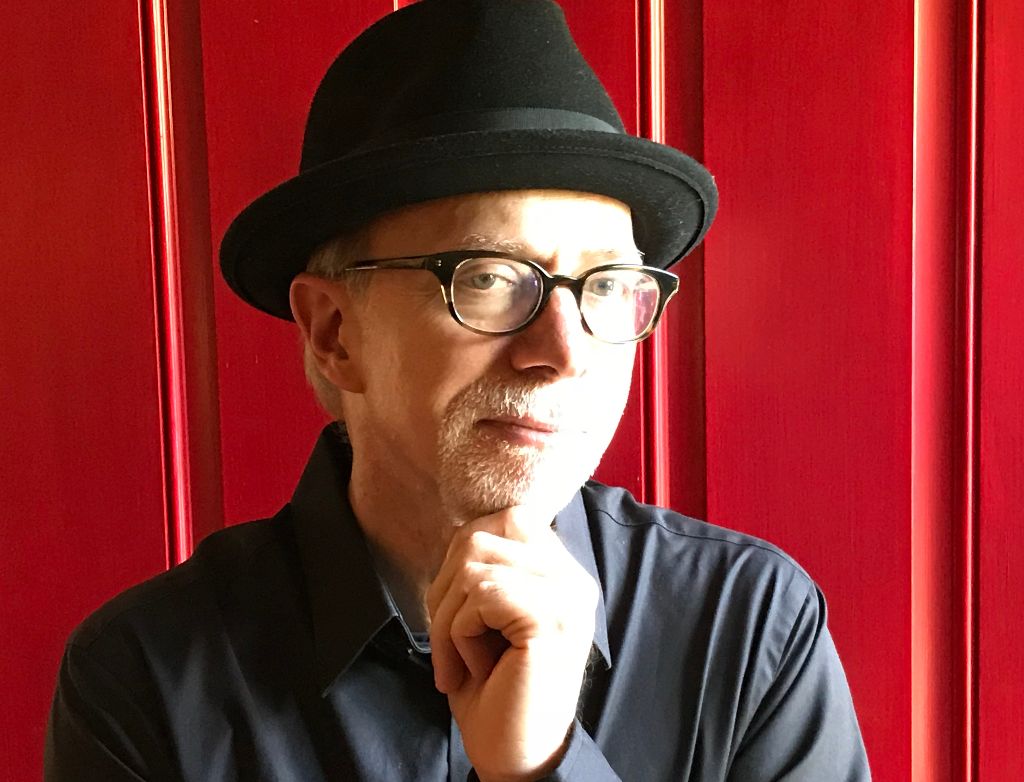
Joe is a freelance journalist who has, over the past few decades, interviewed hundreds of guitarists for Guitar World , Guitar Player , MusicRadar and Classic Rock . He is also a former editor of Guitar World , contributing writer for Guitar Aficionado and VP of A&R for Island Records. He’s an enthusiastic guitarist, but he’s nowhere near the likes of the people he interviews. Surprisingly, his skills are more suited to the drums. If you need a drummer for your Beatles tribute band, look him up.
“John Paul Jones is one of the only musicians I’ve been around where I was starstruck. I asked him some stupid questions about Achilles Last Stand… but he was very kind!” Pearl Jam’s Jeff Ament names 11 bassists who shaped his sound
Fender's guitar models explained: We break down the entire Fender line-up from Player to Custom Shop, to help you find the right one for you
"This American institution has not only changed the face of the guitar forever but has shaped the course of popular music": 5 Fender innovations that changed the world of guitar
Most Popular
The Beatles’ ‘Let It Be’ Film Will Be Available for the First Time in Over 50 Years
By Angie Martoccio
Angie Martoccio
If you purchase an independently reviewed product or service through a link on our website, Rolling Stone may receive an affiliate commission.
In May 1970, Let It Be premiered, and not a single Beatle showed up. The film was a bleak portrayal of the world’s greatest band falling apart, released just weeks after Paul McCartney officially announced their split. It’s been largely unavailable for decades, but all of that will change on May 8, when the film arrives on Disney+ .
Arriving on the streaming platform 54 years to the month that it hit theaters, Let It Be was directed by Michael Lindsay-Hogg and restored by Peter Jackson — who recently combed through 60 hours of footage to create the now-classic docuseries Get Back . In 2020, Jackson told us that he was initially wary of the project (“I thought, ‘I should be excited, but I just dread what I’m about to see'”), but he soon realized there was a treasure trove of happier moments to unearth (“It’s not really a breakup film in the slightest”).
Come for the Torture, Stay for the Poetry: This Might Be Taylor Swift's Most Personal Album Yet
Taylor swift unveils double album ‘the tortured poets department: the anthology’, dickey betts, allman brothers band singer-guitarist, dead at 80, taylor swift busts out the quill pen and delivers an epic double album with 'ttpd: the anthology'.
“I’ve always thought that Let It Be is needed to complete the Get Back story,” added Jackson. “Over three parts, we showed Michael and the Beatles filming a groundbreaking new documentary, and Let It Be is that documentary — the movie they released in 1970. I now think of it all as one epic story, finally completed after five decades. The two projects support and enhance each other: Let It Be is the climax of Get Back , while Get Back provides a vital missing context for Let It Be . Michael Lindsay-Hogg was unfailingly helpful and gracious while I made Get Back, and it’s only right that his original movie has the last word … looking and sounding far better than it did in 1970.”
The news of Let It Be arrives days after the release of Ringo Starr ‘s new single “ February Sky ” and Beyoncé’s rendition of “ Black Bird, ” which McCartney said he was “ so happy ” about. Earlier this year, Sony Pictures announced that Sam Mendes will direct four films centered on each band member , slated for release in 2027.
Frank Zappa's Five-Hour 'Dress Optional' 1968 Concert at the Whisky Will Finally Come Out
- By Kory Grow
Meet Laundry Day, the Funniest Band on Your ‘For You’ Page
- By Jeff Ihaza
Clara Bow's Family Calls Taylor Swift Song a 'Testament' to Actress' 'Legacy'
- Back to the Twenties
- By Tomás Mier
Taylor Swift, Drake, Hozier, and All the Songs You Need to Know This Week
- By Rolling Stone
Pink Files Legal Action Against Pharrell Williams Over Musician's Proposed P.Inc. Trademark
Most popular, ryan gosling and kate mckinnon's 'close encounter' sketch sends 'snl' cold open into hysterics, the rise and fall of gerry turner's stint as abc's first 'golden bachelor', i dream of jeannie’s barbara eden showed everyone she’s even more magical at 92 with this rare tribute, masters 2024 prize money pegged at $20m, up $2m from prior year, you might also like, which new taylor swift songs are about matty healy, joe alwyn or travis kelce breaking down ‘tortured poets department’ lyric clues, jenna lyons talks next season of ‘rhonyc,’ white house parties and j. crew, the best yoga mats for any practice, according to instructors, j.b. smoove calls michael j. fox’s ‘curb your enthusiasm’ appearances ‘the bravest sh*t i’ve ever seen’, legends promotes levy to ceo, mirhashemi becomes vice chair.
Rolling Stone is a part of Penske Media Corporation. © 2024 Rolling Stone, LLC. All rights reserved.
Verify it's you
Please log in.

Rare 54-year-old Beatles movie ‘Let It Be’ will stream for the first time ever
Let it be available!
The Beatles’ 1970 documentary “Let It Be,” which has never been on any streaming service, Blu-ray Disc or DVD format, will finally land on Disney+.
The 54-year-old documentary that followed the band as they recorded their 12th and final studio album will land on the streamer on May 8, Disney announced Tuesday.
It features a famous scene in which Paul McCartney, John Lennon, George Harrison and Ringo Starr perform a spontaneous concert on the rooftop of Apple Corps in London — only to be shut down by the cops.
Disney isn’t just dropping the flick willy-nilly. “Let It Be” has been restored by Beatles’ director Peter Jackson, who was also responsible for the popular “The Beatles: Get Back.”
The announcement of the rare film’s release will make fans twist and shout. Until now, the doc had only officially been sold on out-of-print — and grainy — VHS and laserdisc copies.
Reviews of “Let It Be” weren’t euphoric at the time, but The Post enjoyed it.
“The most remarkable thing about the picture is the way it sustains interest, so unexpectedly, throughout the long session and without all the written assists that customarily pep up entertainments of this sort,” Post critic Archer Winsten wrote in May 1970.
Director Michael Lindsay-Hogg, 83, said in a statement that the release was hampered by the Beatles’ recent split.
“ ‘Let It Be’ was ready to go in October/November 1969, but it didn’t come out until April 1970,” he said. “One month before its release, The Beatles officially broke up. And so the people went to see ‘Let It Be’ with sadness in their hearts, thinking, ‘I’ll never see The Beatles together again. I will never have that joy again,’ and it very much darkened the perception of the film.”
But, Lindsay-Hogg added, this new version brings the film new life.
“I was knocked out by what Peter was able to do with ‘Get Back,’ using all the footage I’d shot 50 years previously,” he said.
More than a half-century after The Beatles broke up, the band has been having a big year.
Their newly released song “Now and Then,” which was completed with the help of AI, debuted at No. 7 on the Billboard Hot 100.
And it’s been announced that “1917” director Sam Mendes plans to direct a four-part series of bio pics — one for each Beatle.
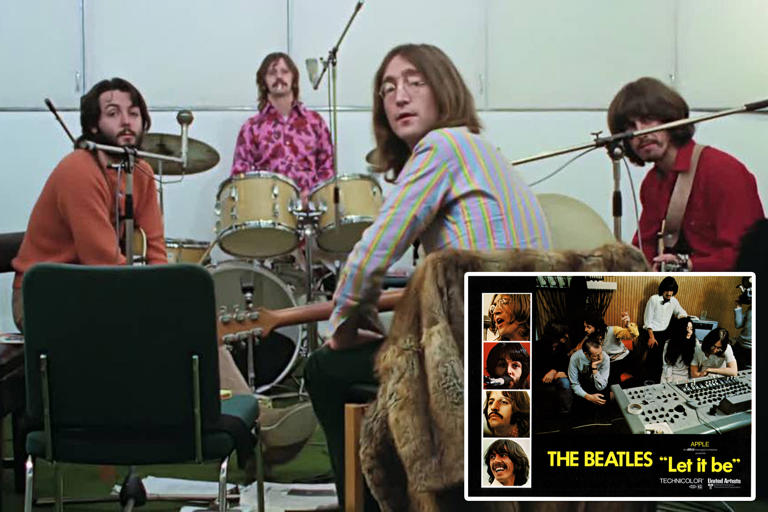

IMAGES
VIDEO
COMMENTS
The English rock group the Beatles toured the United States and Canada between 19 August and 20 September 1964. The 32 concerts comprised the second stage of a world tour that started with the band's tour of Europe, Hong Kong, and Australia and finished with their UK Autumn tour. The shows in the United States were a return to the country after their brief February 1964 tour.
February 11th marks the 48th anniversary of the Beatles' first concert in America. Two days earlier, the group introduced themselves to the nation by performing on New York-based "The Ed Sullivan Show." The "Fab Four" from Liverpool were famously met by more than 3,000 hysterical and nearly riotous fans at JFK airport when they first arrived in ...
Beatles' first live U.S. show 10 photos For talents like Frank Sinatra or Judy Garland, promoters were accustomed to paying appearance fees of $10,000 to $15,000 ($75,000 - $112,000 today). They ...
WASHINGTON - AN 'I WAS THERE' MOMENT. The Beatles perform at the Coliseum in Washington, D.C., Feb. 12, 1964, during their first American tour. The British band members are, in foreground, Paul McCartney and John Lennon; Ringo Starr on drums; and George Harrison on guitar, far right.
The Beatles made their U.S. concert debut on Feb. 11, 1964 in Washington, D.C., two days after their appearance on The Ed Sullivan Show. They'd arrived from New York by train at Union Station in ...
The Beatles In the USA," "The Beatles: The First U.S. Visit"): All kinds of funny things happened on the train. They were behaving for the camera. They were behaving for the camera.
On February 7, 1964, Pan Am Yankee Clipper flight 101 from London Heathrow lands at New York's Kennedy Airport—and "Beatlemania" arrives. It was the first visit to the United States by the ...
The Beatles: The First U.S. Visit is a 1990 re-edited version of the 1964 16mm documentary What's Happening! The Beatles in the U.S.A., about the Beatles' first visit to America in February 1964. Made by documentary filmmakers Albert and David Maysles, it documents the Beatles' U.S. trip as they travel to New York City, Washington, D.C., and Miami Beach.
Ringo. The Beatles First US Visit chronicles the remarkable two weeks in February 1964 that began America's still-enduring love affair with the group. The film of the frantic fortnight records the hysterical reaction to The Beatles US debut in a documentary that was the real-life inspiration for the Beatles movie A Hard Day's Night.
Beatlemania In D.C.: 60 Years Ago, The Beatles Performed Their First U.S. Concert At The Washington Coliseum. Long before it was the site of REI's flagship D.C. location, a La Colombe coffee ...
After recovering from the concert, the group headed to the British Embassy to attend a charity ball. Having played their first American concert the night before in front of over 8,000 screaming fans, the Beatles awoke in an excited mood. They got a mini-tour of the nation's capitol and then headed back to New York by train.
Tuesday 11 February 1964 Live 16 Comments. The Beatles' first US concert was watched by a crowd of 8,092 fans at the Washington Coliseum in Washington, DC. The band had traveled from New York to Washington, DC early in the day by rail, as an East Coast snowstorm had caused all flights to be cancelled. A special sleeper carriage was attached ...
On 9 February 1964, the Beatles made their first live US television appearance. 73 million viewers —about two fifths of the total American population— watched the group perform on The Ed Sullivan Show. Two days after the television appearance, on 11 February 1964, the Beatles' first US concert took place, at Washington Coliseum, a sports ...
February 11, 1964: the Beatles performed in the United States for the first time. 50 years on and we return to the scene -- a DC boxing ring -- with the phot...
7th February, 1964 - Beginning of First US Tour. Related Articles. News. Beyonce and "Blackbird" Image. News. Ringo Plays On Mark Knopfler's Guitar Heroes - Going Home (Theme From Local Hero) ... Share this website. The Beatles Twitter profile. The Beatles Instagram profile. The Beatles Facebook profile. The Beatles YouTube Channel. Search ...
The Beatles in Washington, D.C., Feb. 11, 1964 (YouTube screen shot) Given that just about everyone who loves rock and roll has a gig they'd love to go back in time to attend, it makes sense that every rock and roll band has a dream show. For The Beatles, that had to have been February 11, 1964, when they performed their first concert in ...
His first-hand, insider's memoir, the award-winning The Beatles and Me On Tour, 60th Anniversary Book, was published in February. It is a fascinating journey back in time where for the first time he chronicles, frankly and humorously, 34 days with the world's most famous band on the road—at a critical moment in the history of rock.
Go to http://www.NBCUniversalArchives.com to license any portion of this video.February 7, 1964: Beatles First US TourVideo Clip Bin: http://www.nbcuniversal...
The Beatles: The First U.S. Visit. Directed by Albert and David Maysles. Distributed by MPI Home Video (1991) Apple Films (2004) Release dates. 13 November 1991 - VHS/Laserdisc. 3 February 2004 (United States) - DVD. 9 February 2004 (other countries) - DVD. The Beatles: The First U.S. Visit is a 1990 re-edited version of renowned documentary ...
The Beatles arriving for concerts in Madrid, July 1965. From 1962 to 1966, the English rock band the Beatles performed all over the Western world. They began performing live as The Beatles on 15 August 1960 at The Jacaranda in Liverpool and continued in various clubs during their visit to Hamburg, West Germany, until 1962, with a line-up of John Lennon, Paul McCartney, George Harrison, Stuart ...
26th June 1964 - A Hard Day's Night was released in the USA - this was the band's fourth album release in the United States. 19th August 1964 - The Beatles begin their first North American tour in Daly City. 11th September 1964 - The Beatles play at the Gator Bowl Stadium in Jacksonville to an unsegregated audience.
Currently it's at the Chrysler Museum of Art in Norfolk, Va., and comes to the Brooklyn Museum May 3-August 18. (Don't be surprised if the artist shows up for the opening.) It was McCartney ...
This coming 2024, will mark the 60th anniversary of The Beatles First US Tour which included stops in San Francisco, Las Vegas, Vancouver, Los Angeles, Denver, Cincinnati, New York, Atlantic City, Philadelphia, Milwaukee, Indianapolis, Chicago, Detroit, Jacksonville, Boston, Baltimore, Pittsburgh, Cleveland, New Orleans, Kansas City and Dallas ...
After The Beatles split in 1970, Starr released his first solo album, Sentimental Journey. He became the first member of the group with seven consecutive top 10 singles, including "It Don't ...
He'd logged several worldwide tours with David Bowie and played a vital musical role on albums such as Young Americans and Station to Station. As if working with one British rock legend weren't enough, in 1980 Slick was chosen by John Lennon to play guitar on the former Beatle's first album in five years, Double Fantasy .
In May 1970, Let It Be premiered, and not a single Beatle showed up. The film was a bleak portrayal of the world's greatest band falling apart, released just weeks after Paul McCartney ...
The "She Wolf" is coming out of her cage. For the first time since 2018, Shakira will officially tour North America as part of her upcoming 'LAS MUJERES YA NO LLORAN WORLD TOUR' (which ...
Paul McCartney's Iconic Wings Tour Bus Expected To Sell For Over $200 Thousand . From April 22 to 29, the double-decker tour bus that took Paul McCartney's band Wings all over Europe in 1972 will ...
The Beatles staged their second concert tour of the United States (with one date in Canada) in the late summer of 1965.At the peak of American Beatlemania, they played a mixture of outdoor stadiums and indoor arenas, with historic concerts at Shea Stadium in New York and the Hollywood Bowl.Typically of the era, the tour was a "package" presentation, with several artists on the bill.
Director Michael Lindsay-Hogg, 83, said in a statement that the release was hampered by the Beatles' recent split. " 'Let It Be' was ready to go in October/November 1969, but it didn't ...